Corris is a village located approximately six miles from the market town of Machynlleth. Nestled in a valley where two rivers meet, this small village has a rich history connected to slate mining. Today, it hosts popular attractions, including a heritage steam railway and a craft centre.
The walk described in this article takes you around the village and up through the Abercorris woodland, where you can admire the ruins of a former quarry site, before heading north to see a uniquely shaped tunnel.
IN A NUTSHELL
Corris Village Walk
How long is it? It’s about 4.3 miles (6.9 km) and should take about 2 hours.
How easy is it? It’s a moderate hike with a few steep sections. You’ll walk on a mix of tarmac country roads and dirt footpaths, which can be quite muddy after rain. The maximum ascent is 803 feet (245 metres). As always, wear appropriate footwear. Be especially careful around ruins and quarries, as some structures may be unstable. Always respect any safety signs you come across.
Can I bring my children? The walk shouldn’t be too difficult for children over five years old, but make sure they stay on the path, especially around the old quarries. As always, you know your child best and what they can manage.
Accessibility: Most of the footpath is dirt with steep sections, so it is not suitable for people with mobility issues.
Where can I park my car? There is a small car park in Corris, but I’d recommend parking at the Corris Craft Centre instead.
Can I get there by public transport? The T2 bus (Bangor to Aberystwyth) stops on the main A487 road, by Bridge Street, which leads to the centre of Corris.
Are there any amenities nearby? Yes! There are public toilets and the Slater’s Arms pub in the village, toilets and the Corris Café in the Craft Centre just outside the village.
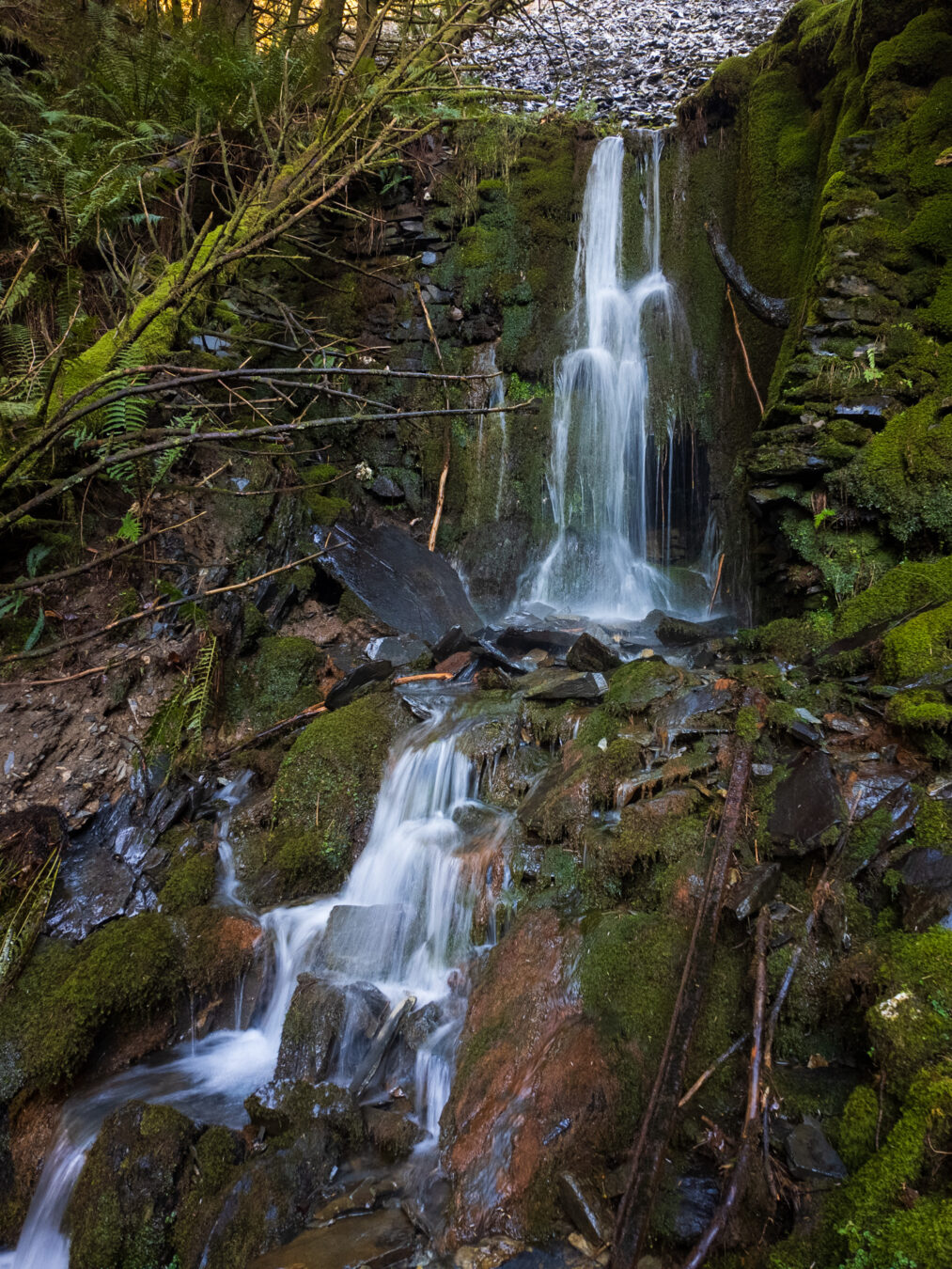
Corris Village Walk Map And Route
The circular walk takes you through the centre and around the east side of the village, briefly following the Afon Dulas (afon means ‘river’ in Welsh) before heading up into the woodlands to reach the ruins of Cwmodyn Quarry. From there, you continue north towards another quarry before making your way back along a country road, which leads you back to the centre of Corris.
Free PDF guide!
- If you subscribe to our newsletter, you’ll get access to our exclusive members’ area, where you can download a mobile-friendly PDF guide and a GPX file of this walk.
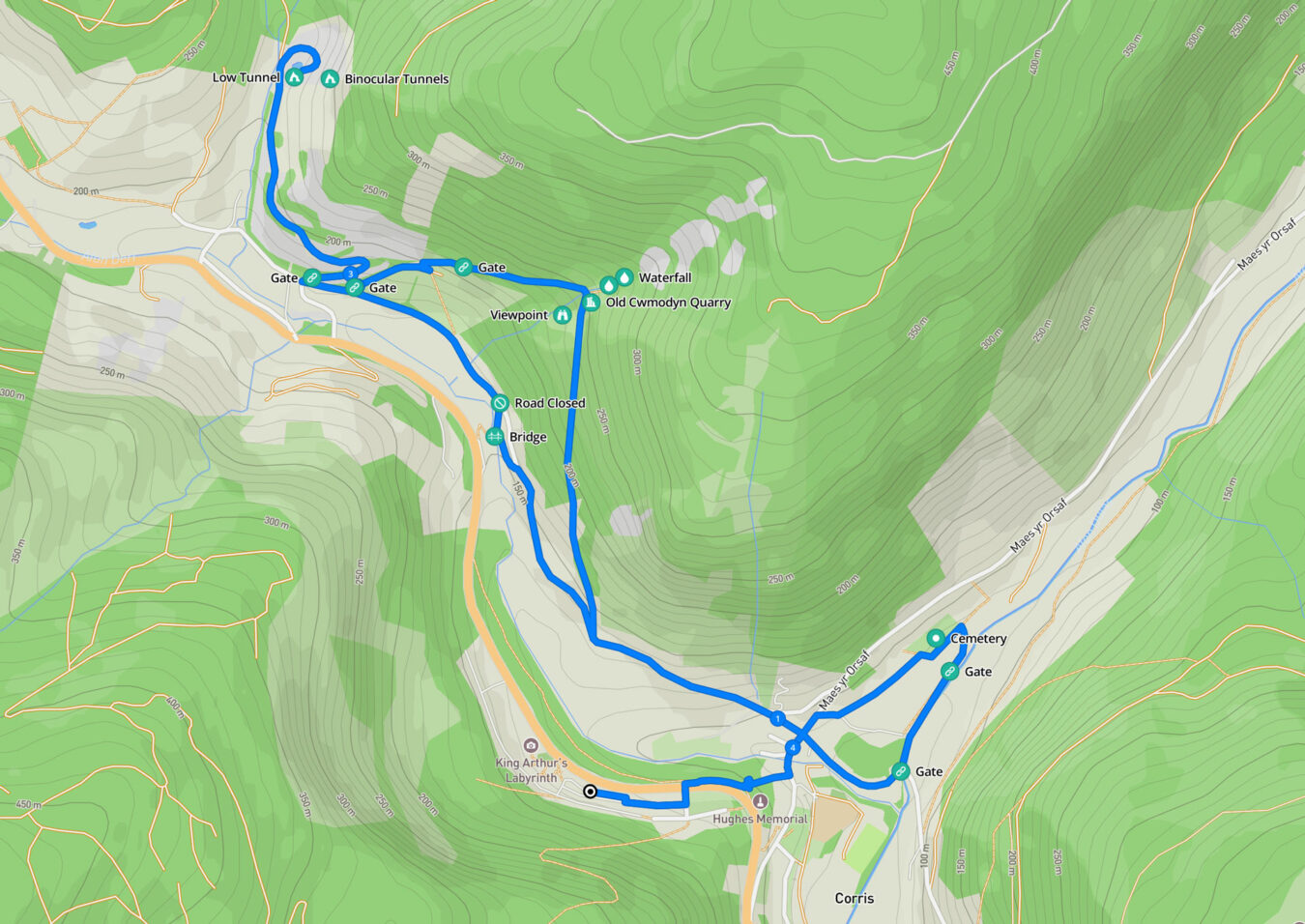
ABOUT CORRIS
- Corris is a former slate mining village set within the Dyfi Forest.
- At its industrial peak, the village had 14 shops, three banks, a bakery, two schools, and even a weekly newspaper.
- The Slater’s Arms, a historic pub, opened in the 1860s and has remained a popular spot for both locals and visitors ever since.
- Today, around 600 people live in Corris. One school is still in operation, and the village also has its own amateur football club.
How To Get To Corris
Corris lies six miles north of Machynlleth. There are two ways to reach the village: by car or by bus.
By Car
You can park either in the village centre or at the Corris Craft Centre. Spaces in the village are quite limited. There is a small car park by the Corris Railway, and you may find a few spaces along Bridge Street, but during busy holiday periods, you’ll have a better chance at the Craft Centre. It offers a large, free car park and the opportunity to explore this unique art centre, which is well worth a visit.
See Corris Craft Centre on
Google Maps | Apple Maps
Note that there are no EV charging stations in Corris or at the Craft Centre. The nearest ones are in Machynlleth, located in the Bank Lane car park, where you’ll find a few 50kW chargers and several 7kW chargers.
By Bus
The T2 bus, which connects Bangor to Aberystwyth, stops at the entrance of the village. From there, it’s a six-minute walk down Bridge Street to reach the centre of Corris. Alternatively, you can alight at the Craft Centre and take the path that leads to the village. Check the bus timetable at Traveline.cymru.
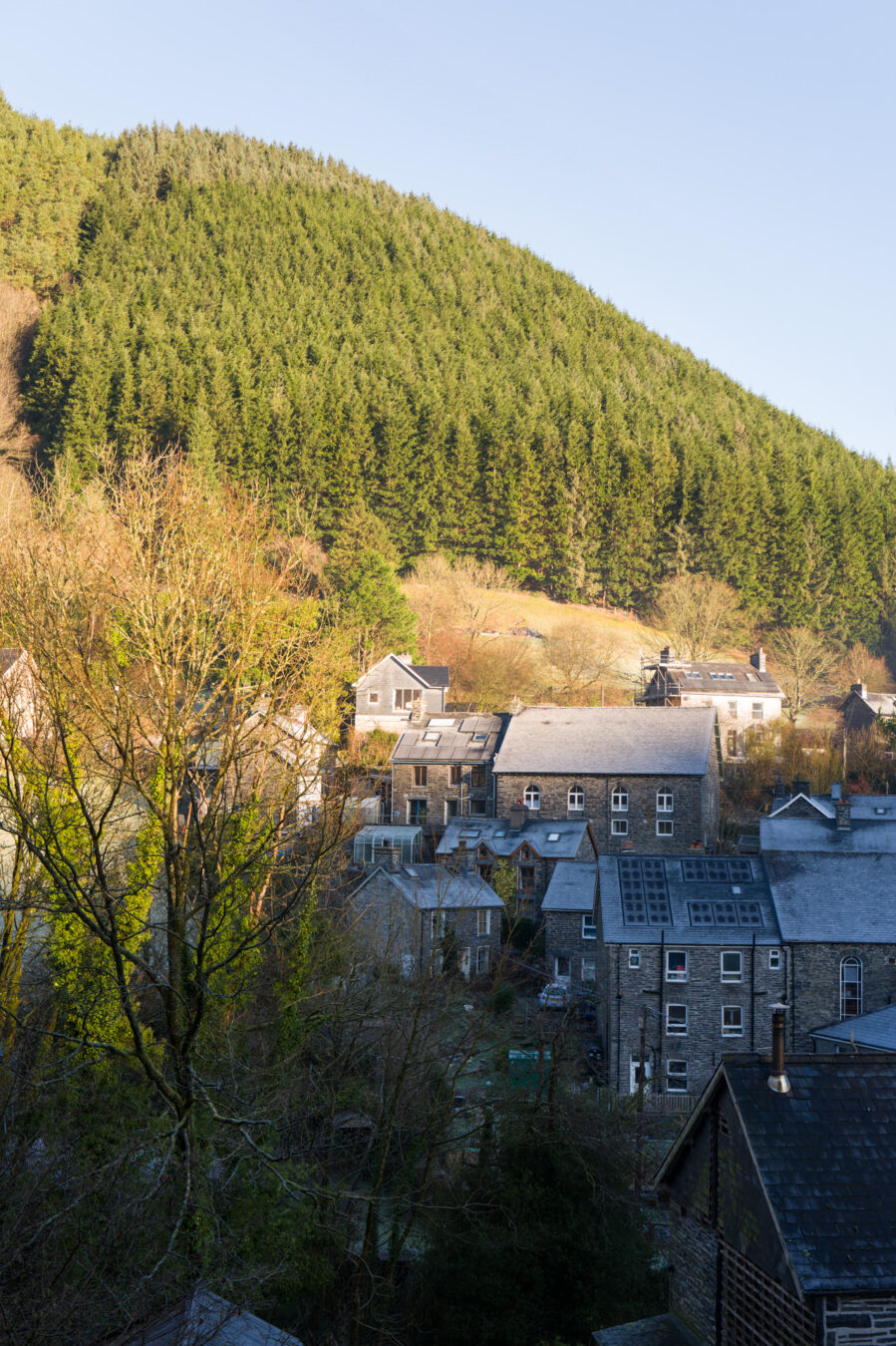
The Corris Village Walk
From the Corris Craft Centre car park, walk away from the centre towards the far end of the car park on the east side. Follow a tarmac track briefly, then turn left to join the main A487 road, where the bus stop is located. Take extra care when crossing this road, as it is a 60mph zone.
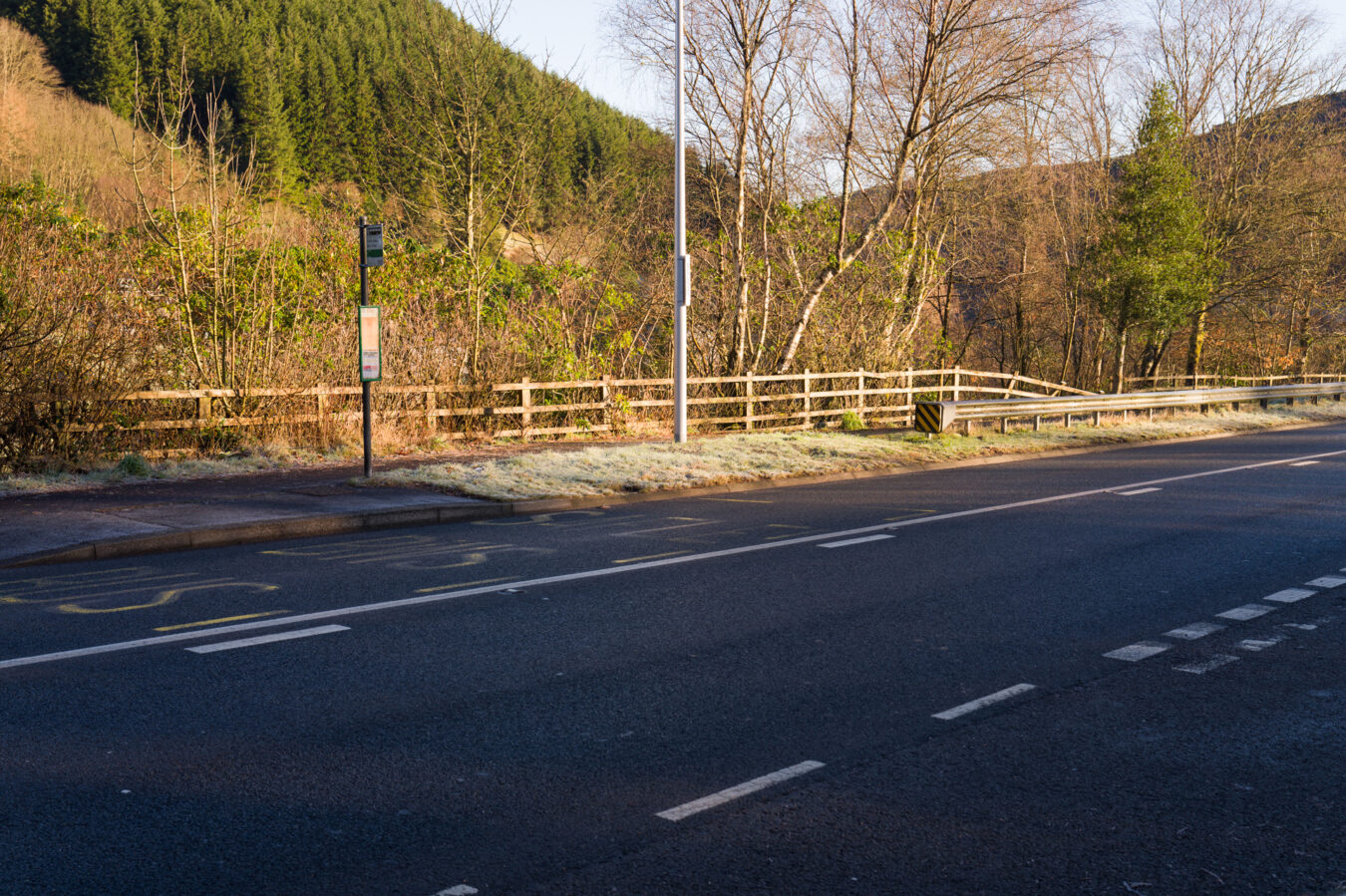
On the other side, turn right and follow the path running alongside the road for about 100 metres (330 ft). Then, take a sharp left and follow the zigzag path leading down into the village centre.
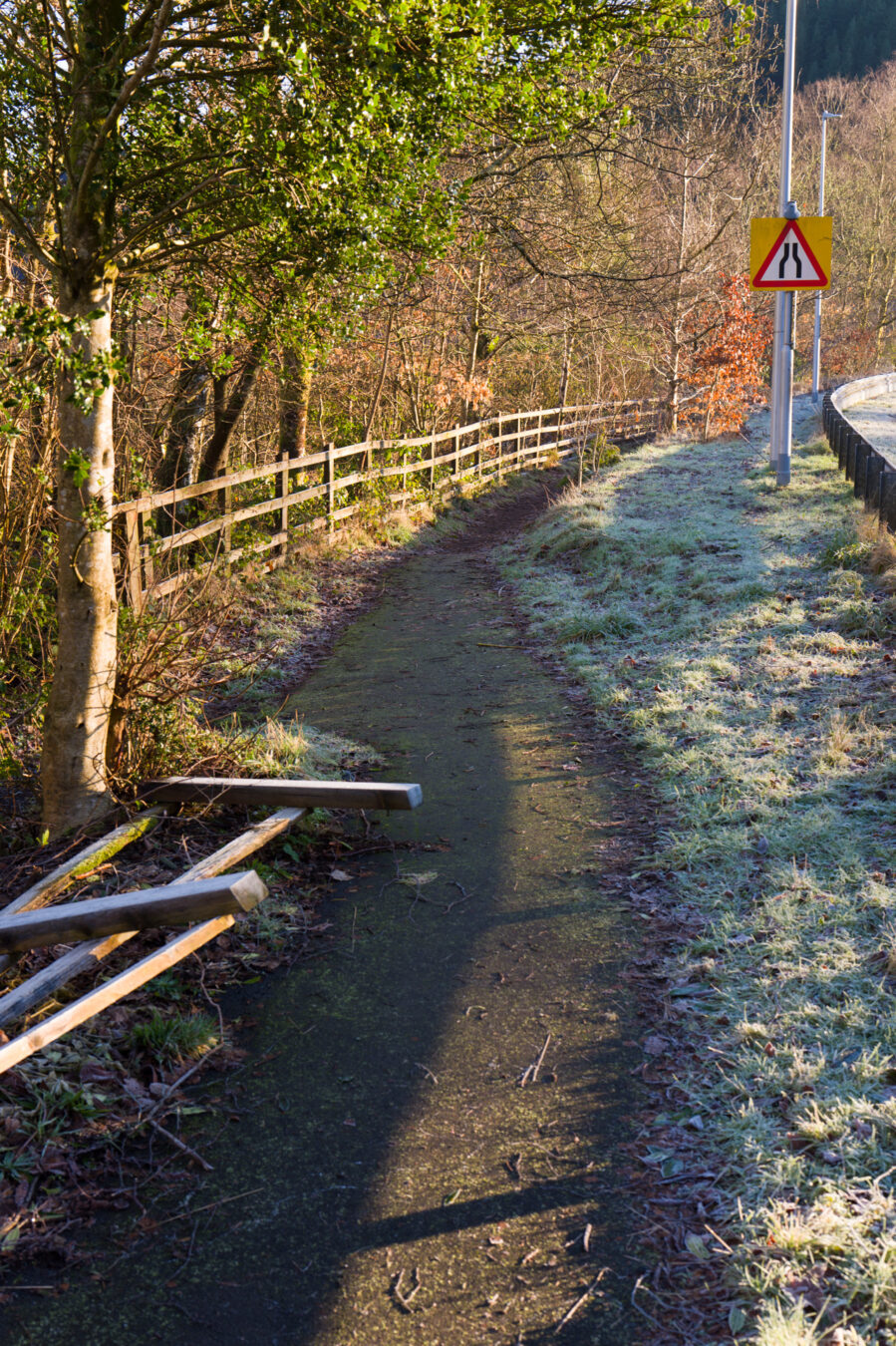
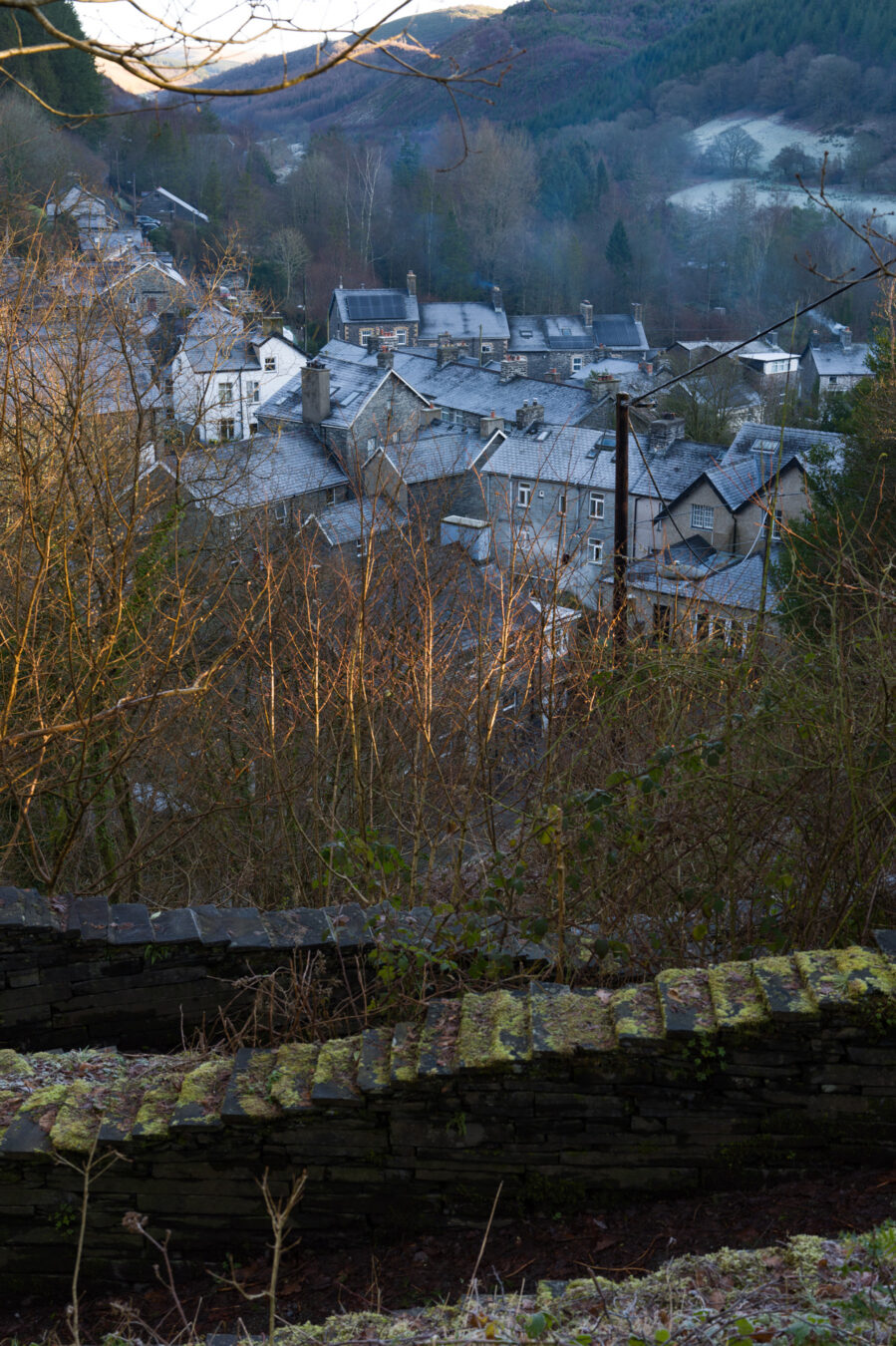

When you reach Bridge Street, turn left. Pass the Corris Institute on your left and continue along the street until you arrive at an intersection, where the Slater’s Arms pub is on the left corner. From here, you can either turn left towards the woodland or take a short circular walk around the village before heading up the hill.
If you choose the village loop first, continue straight past the intersection for about 50 metres (160 ft), until you see a tarmac track descending on your right, and a walking sign next to it. Follow this track down, then almost immediately turn left under a series of arches leading towards the cemetery.
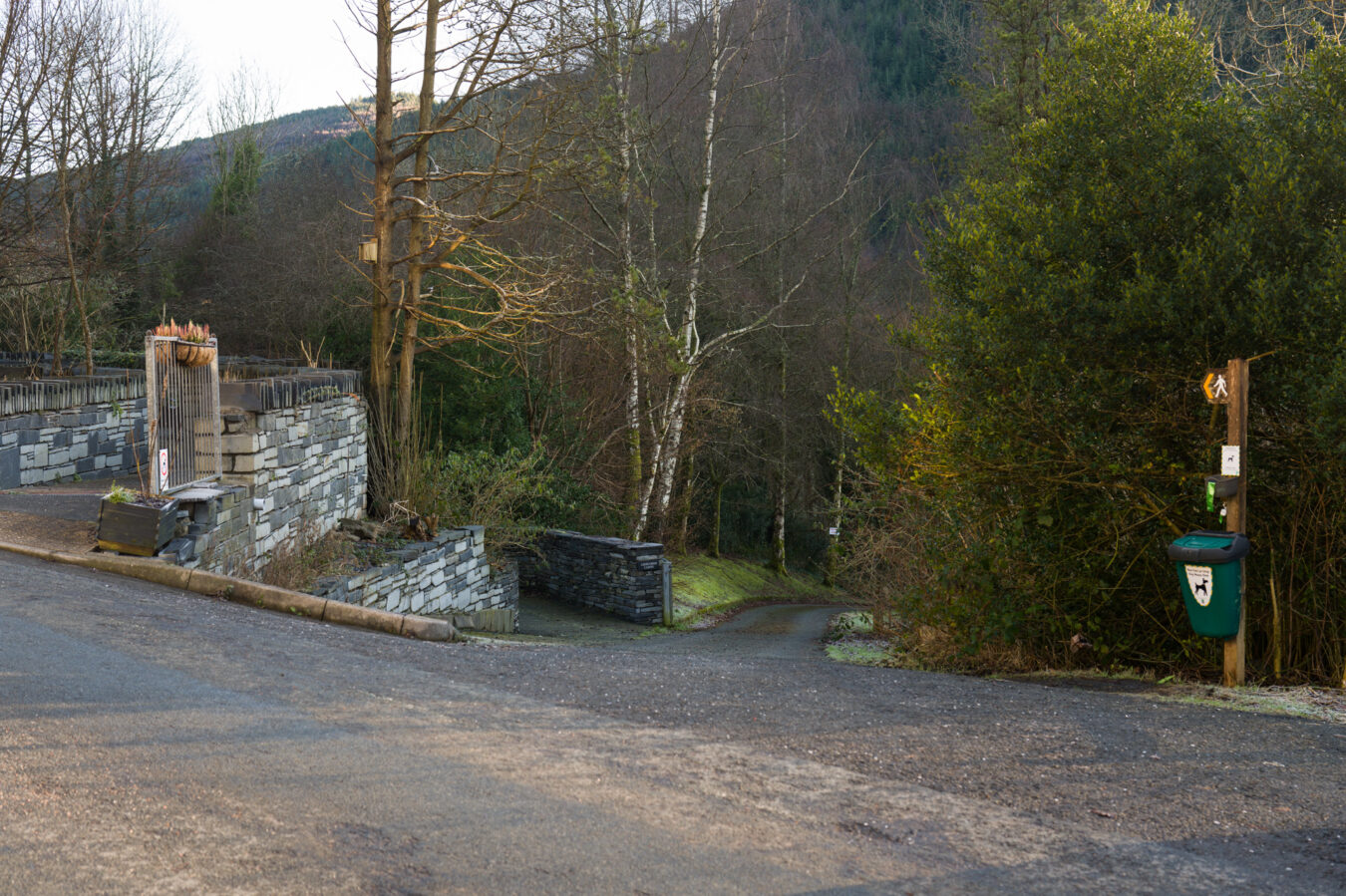
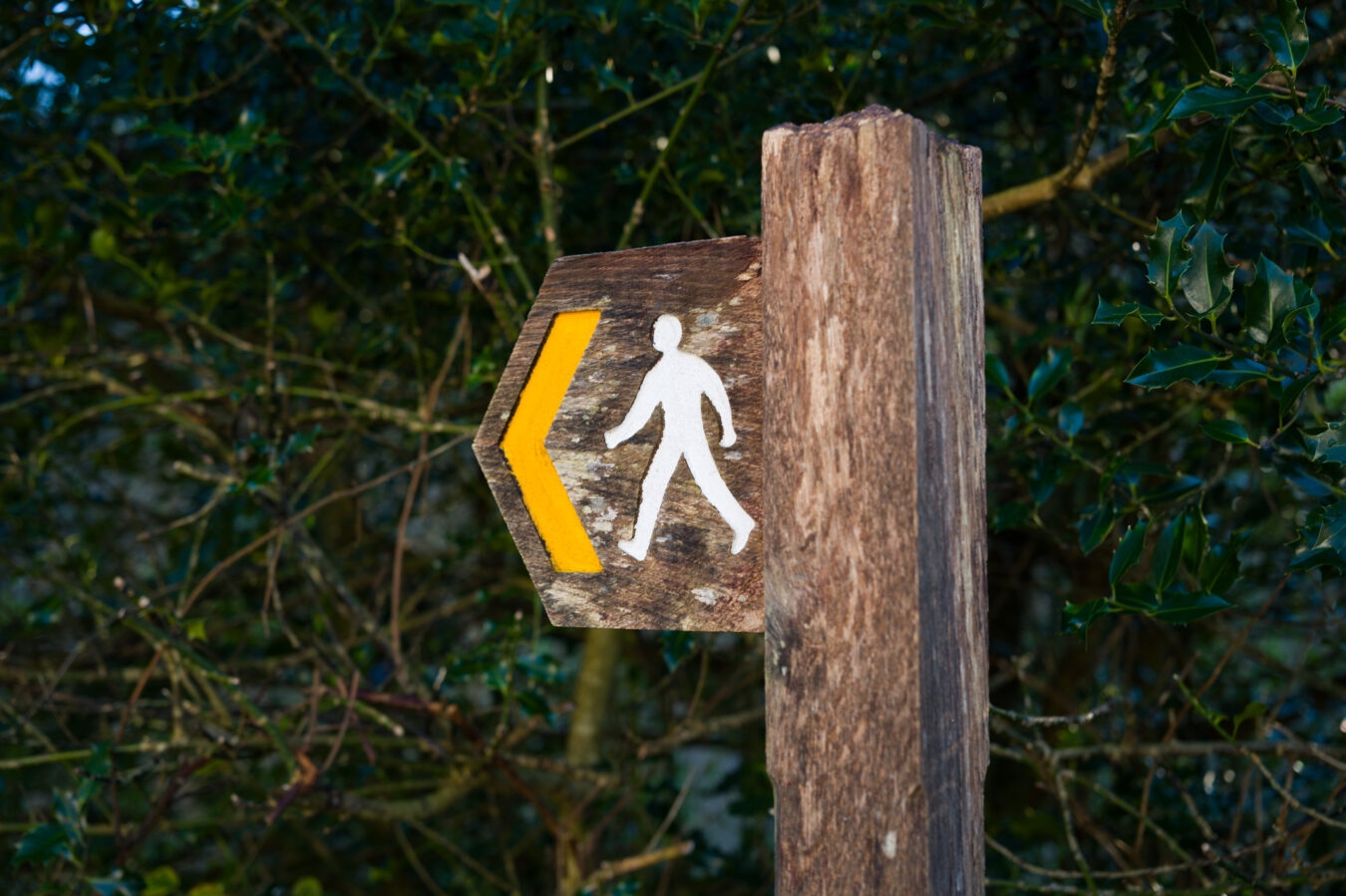
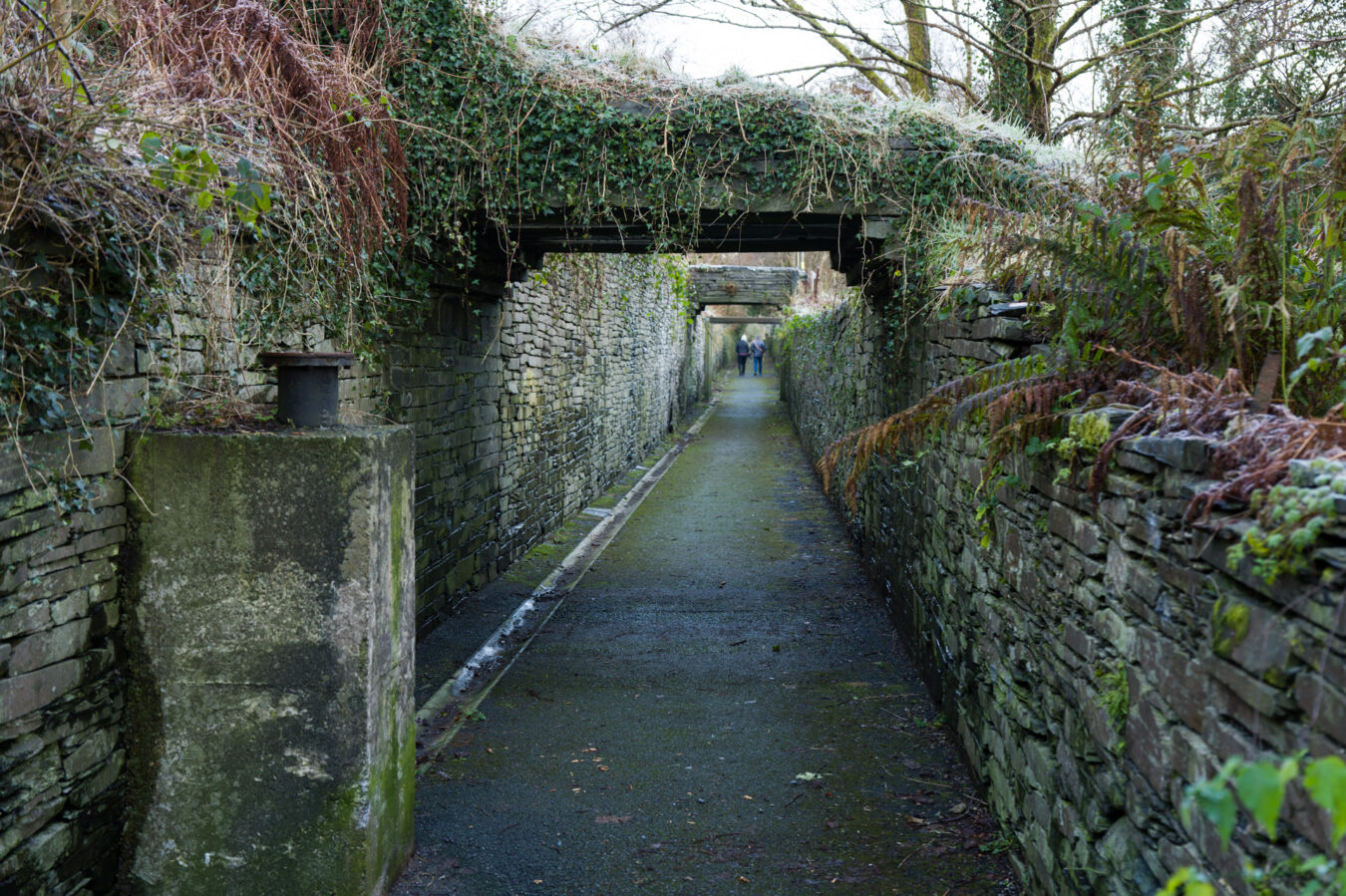
At the cemetery, turn right, then left through a gate onto the field below the graveyard. After passing a second farm gate (usually open), turn right towards the river (Afon Dulas).
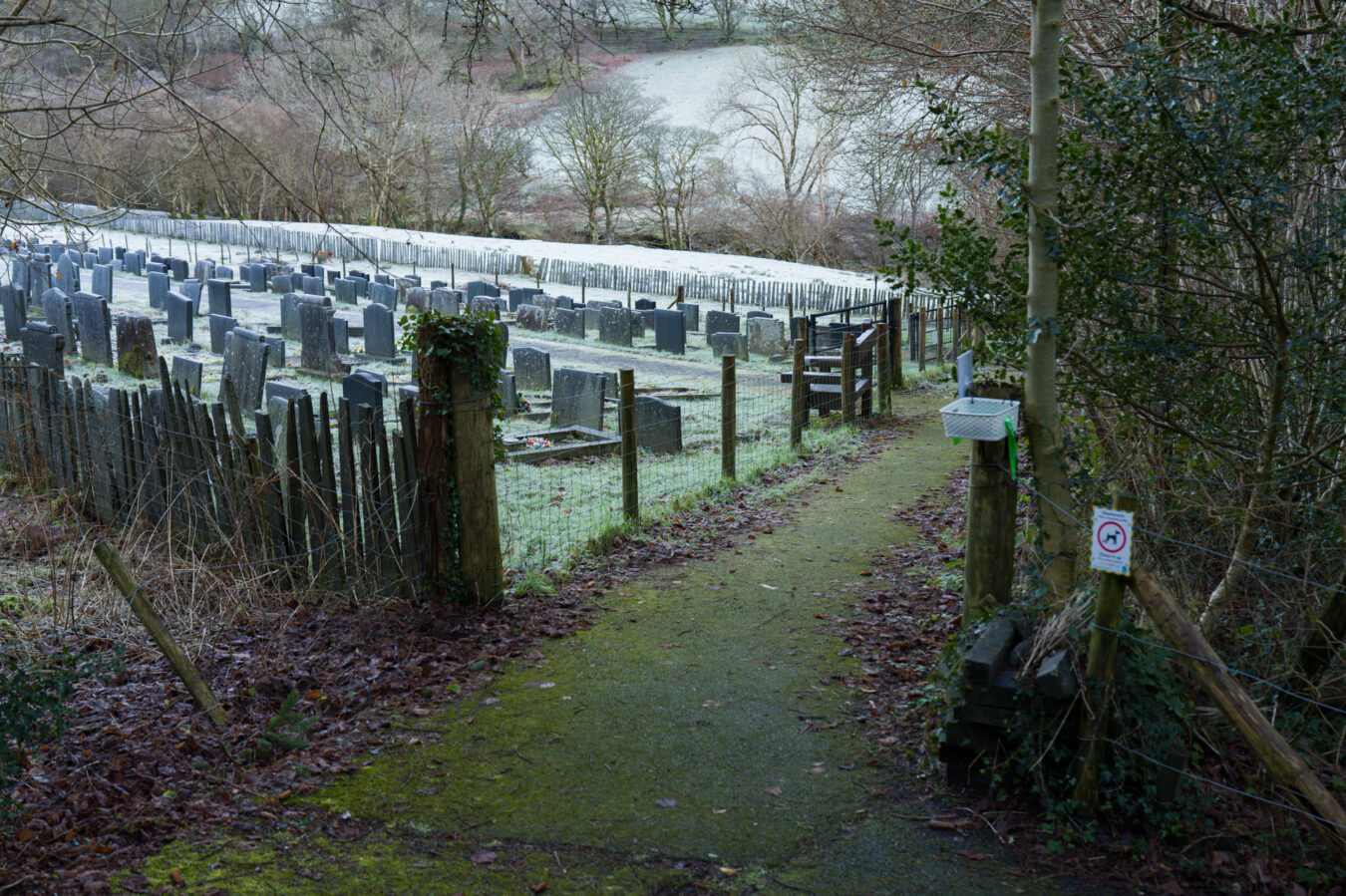
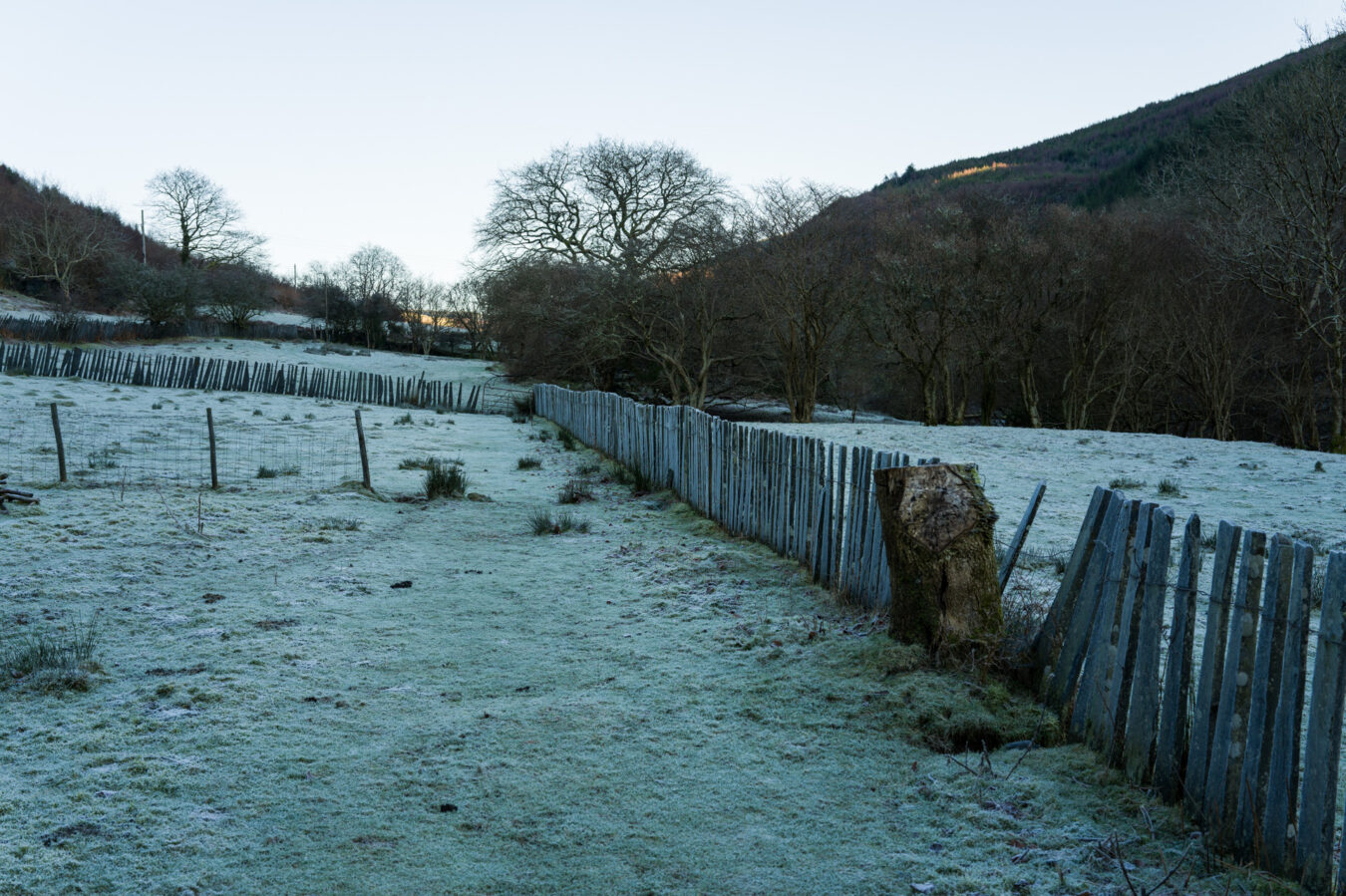
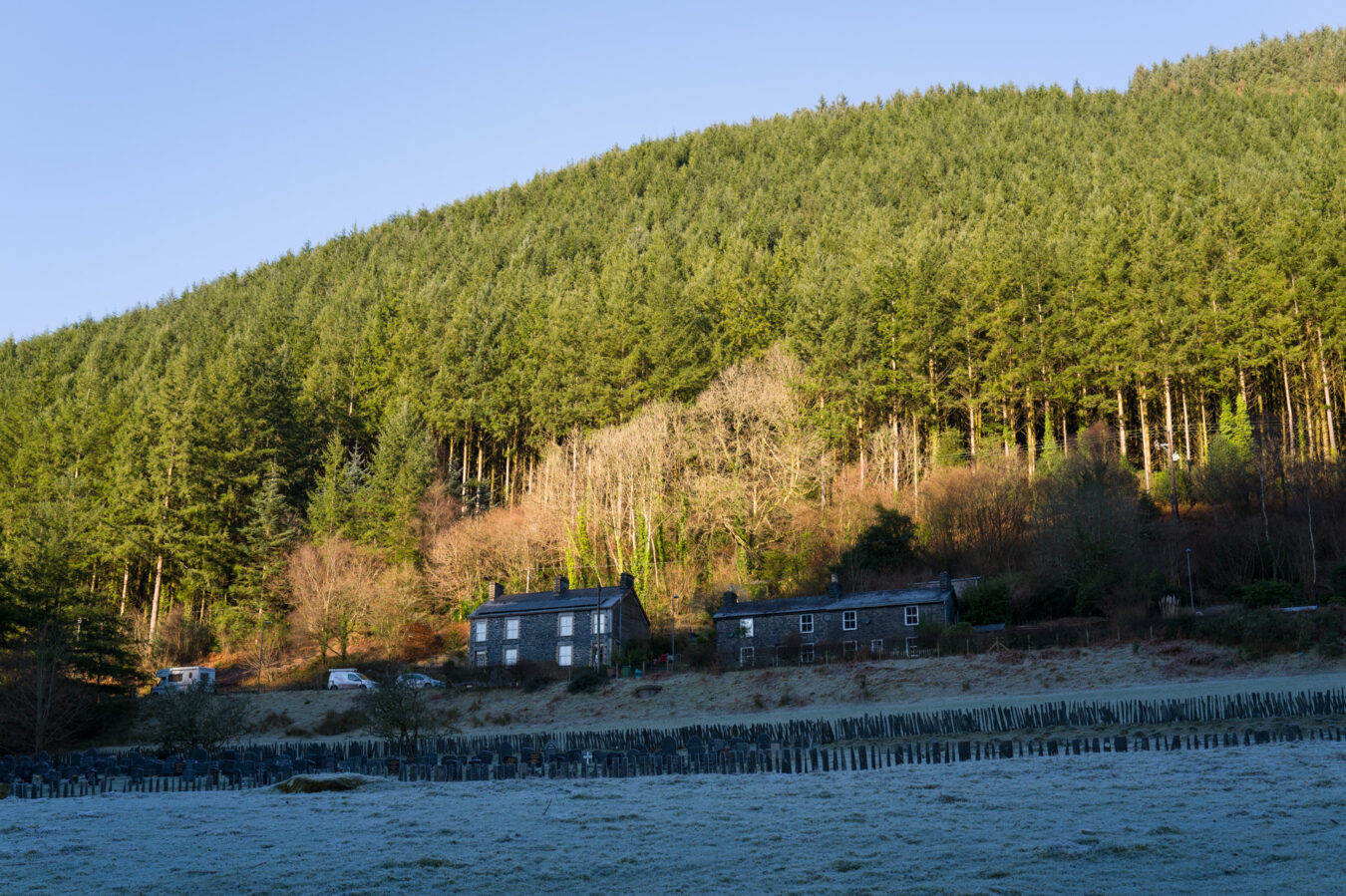
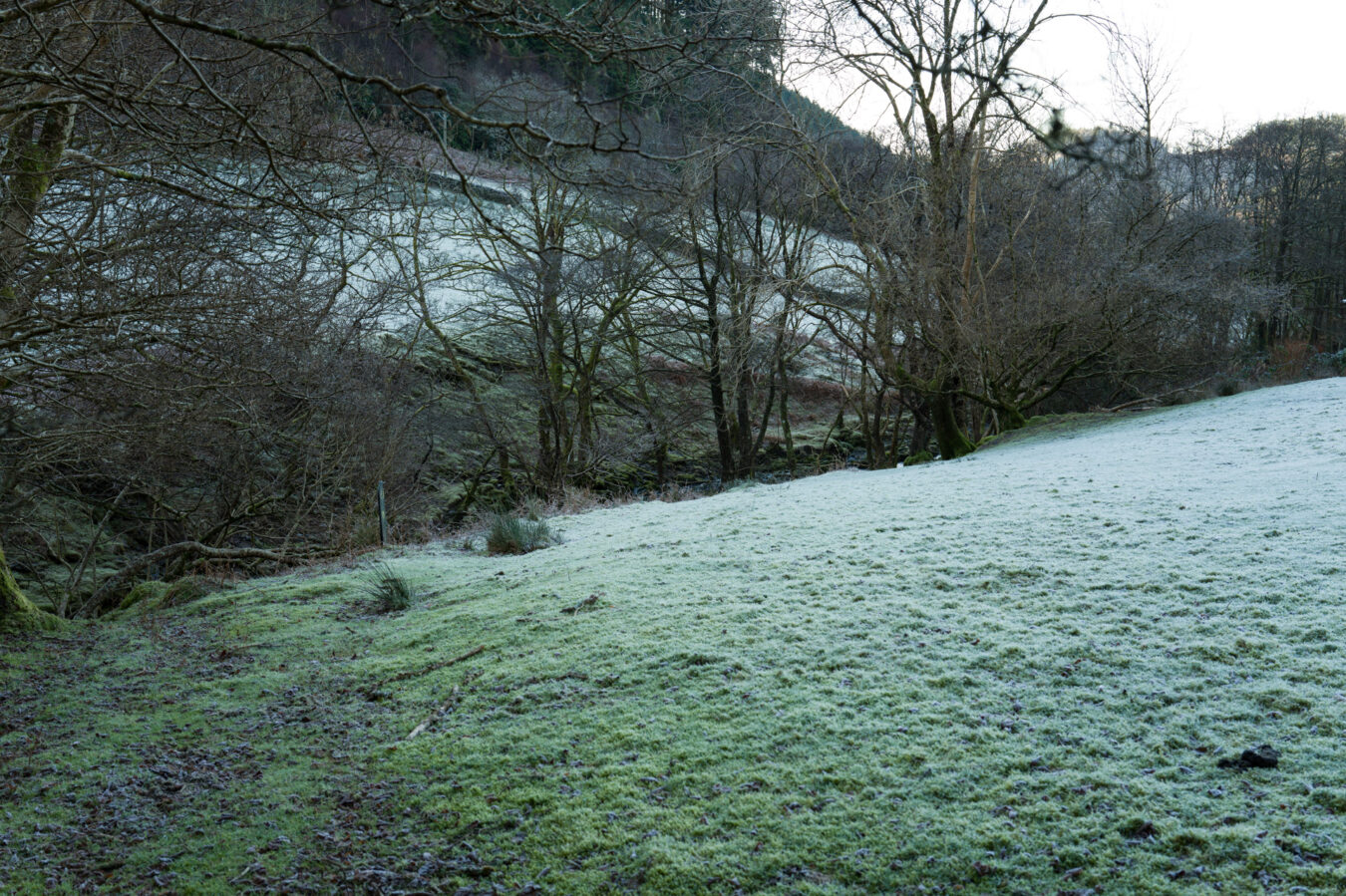
Follow the riverside path, passing a couple of gates, until you reach Minffordd Street. Turn right and follow the street uphill, bringing you back to the intersection by the pub.
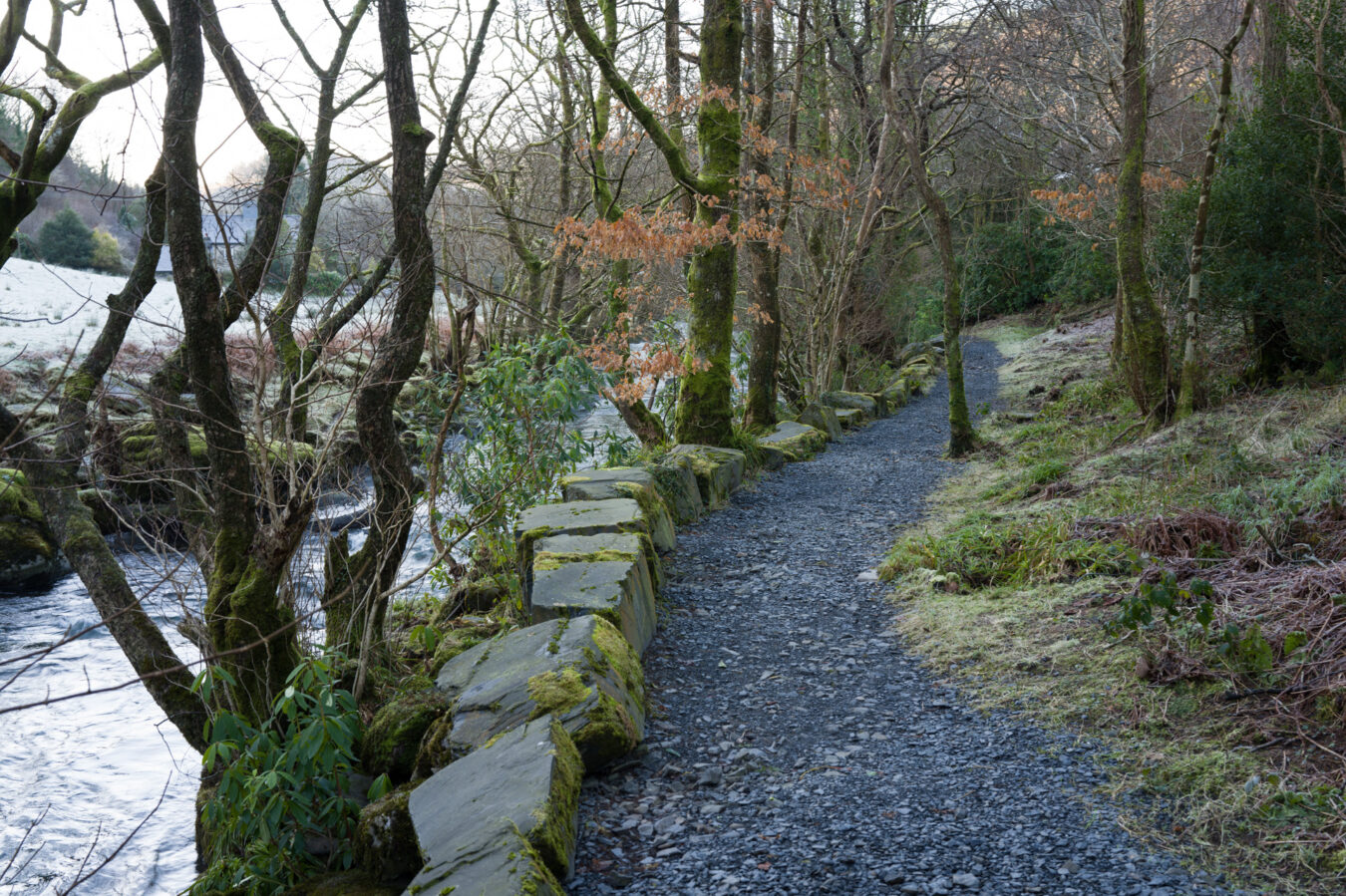
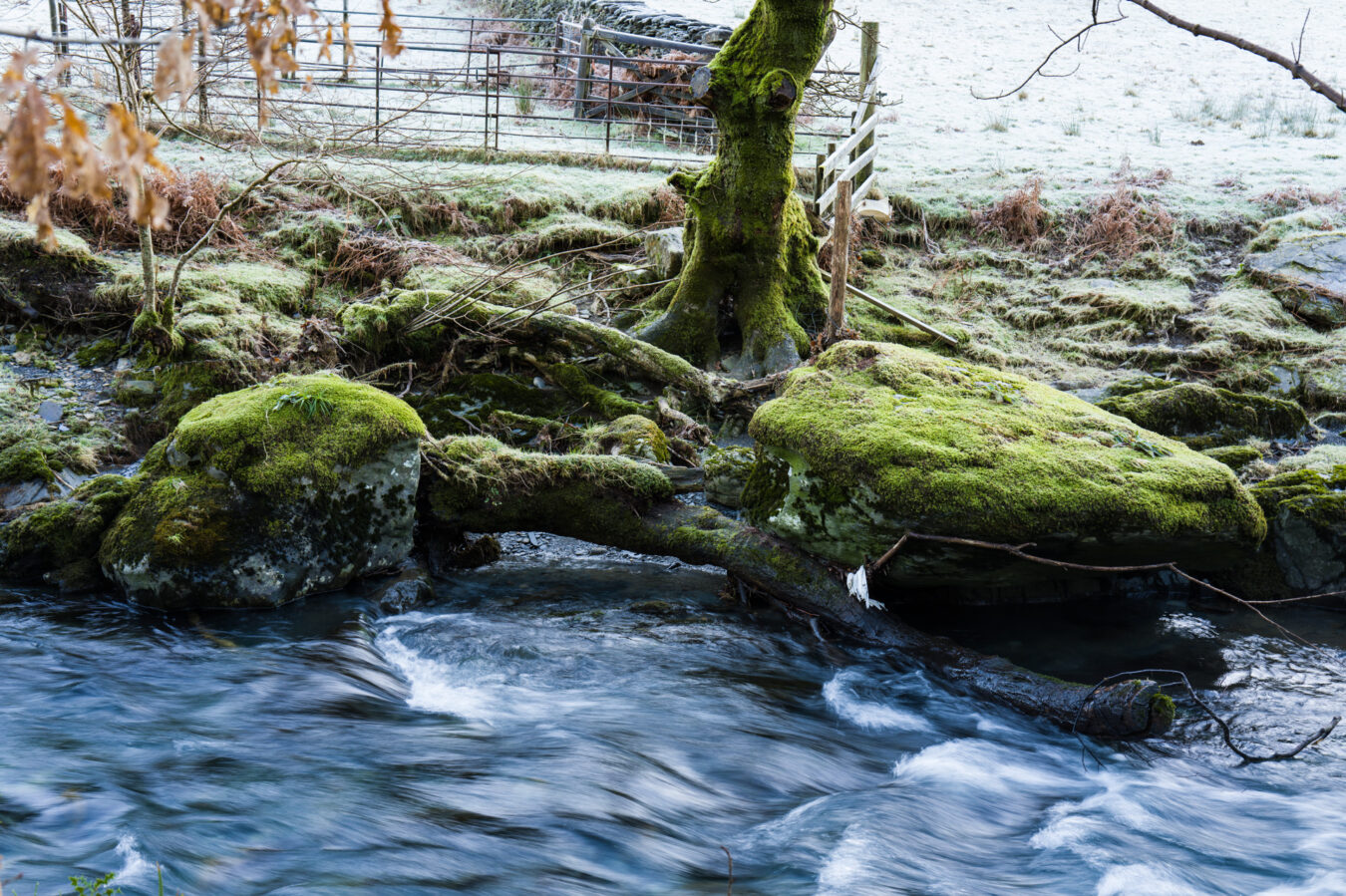
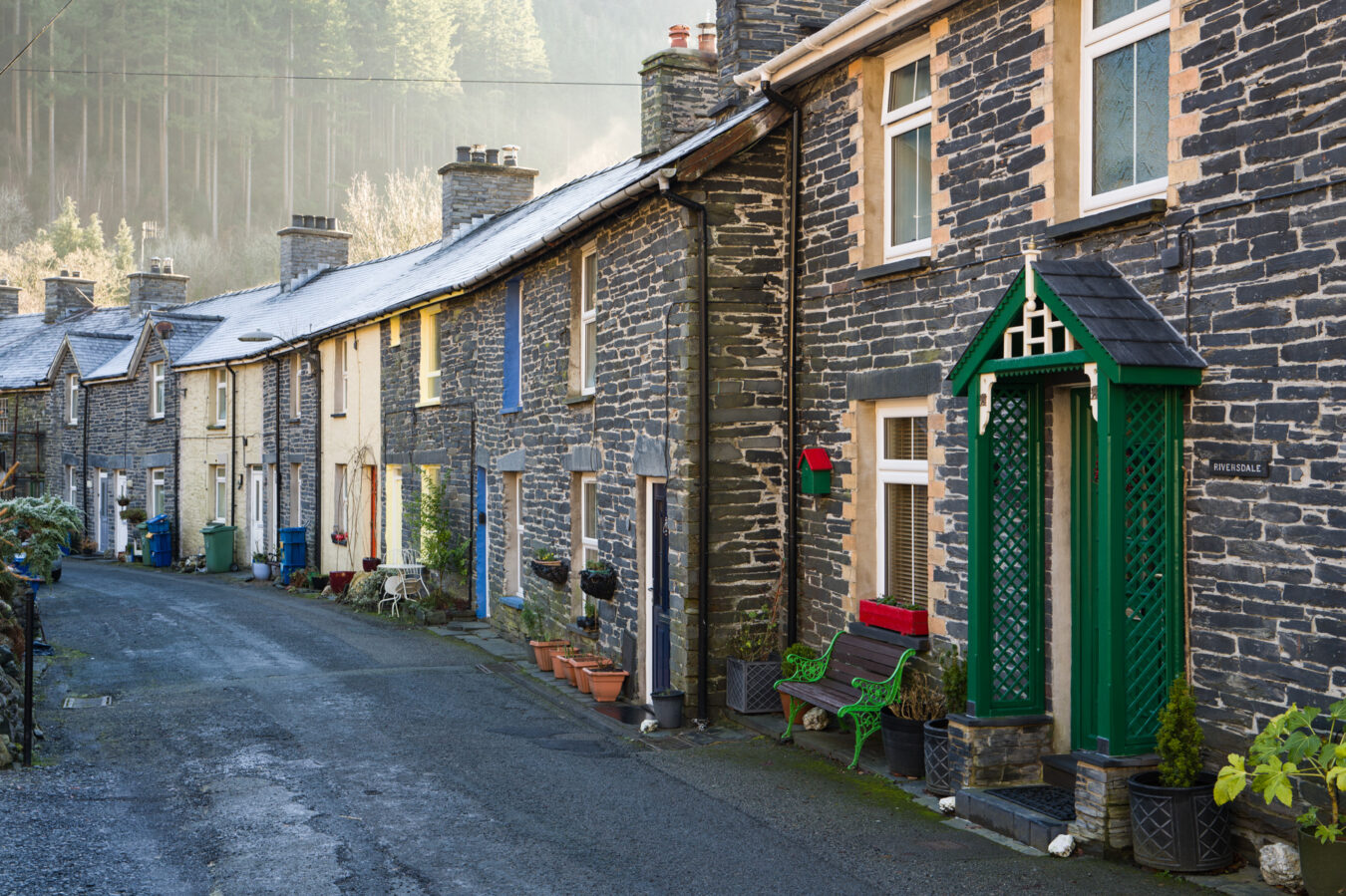
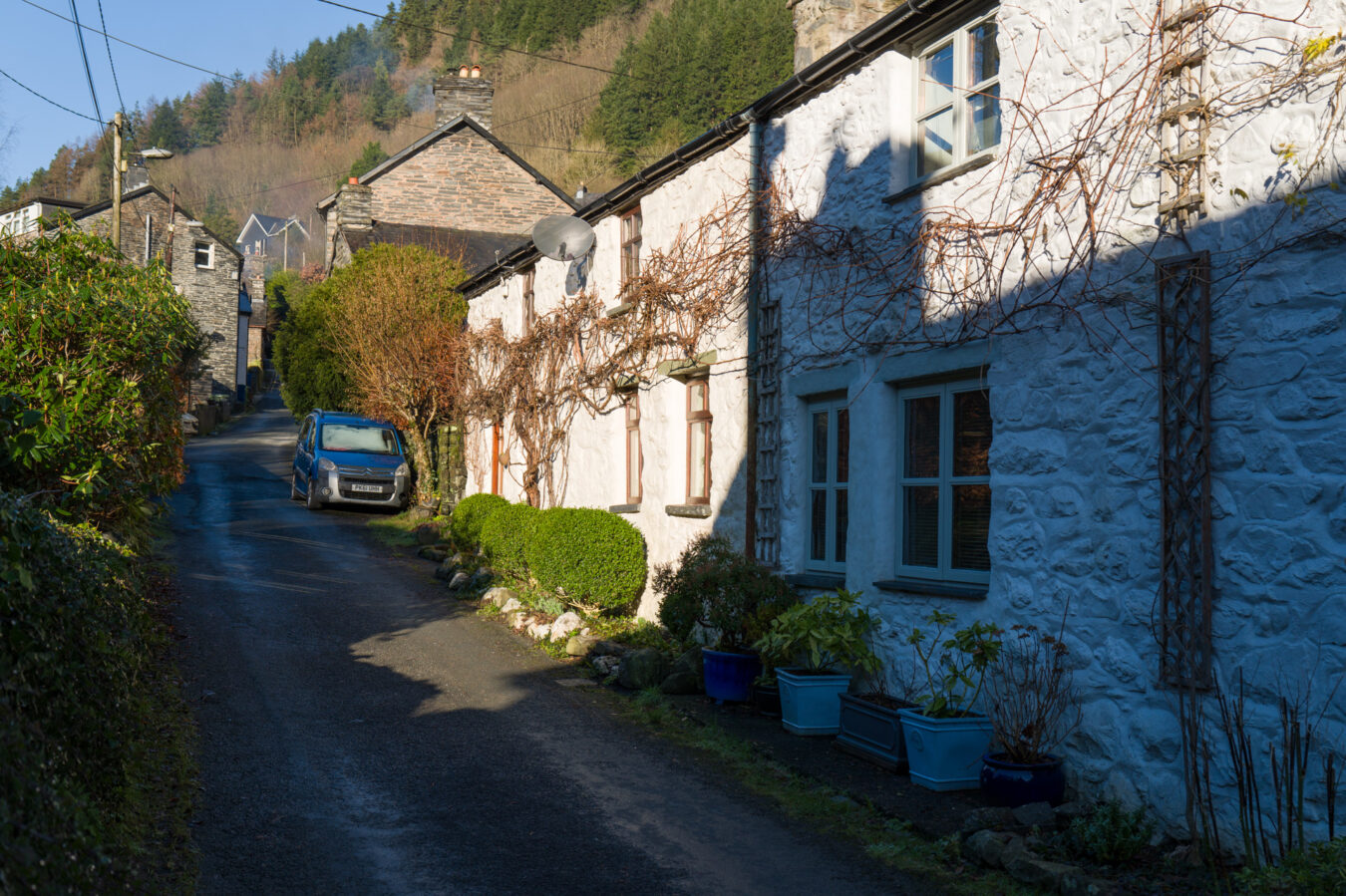
Now it’s time to head up the hill. From Minffordd Street, continue straight through the intersection, following the sign for a hostel.
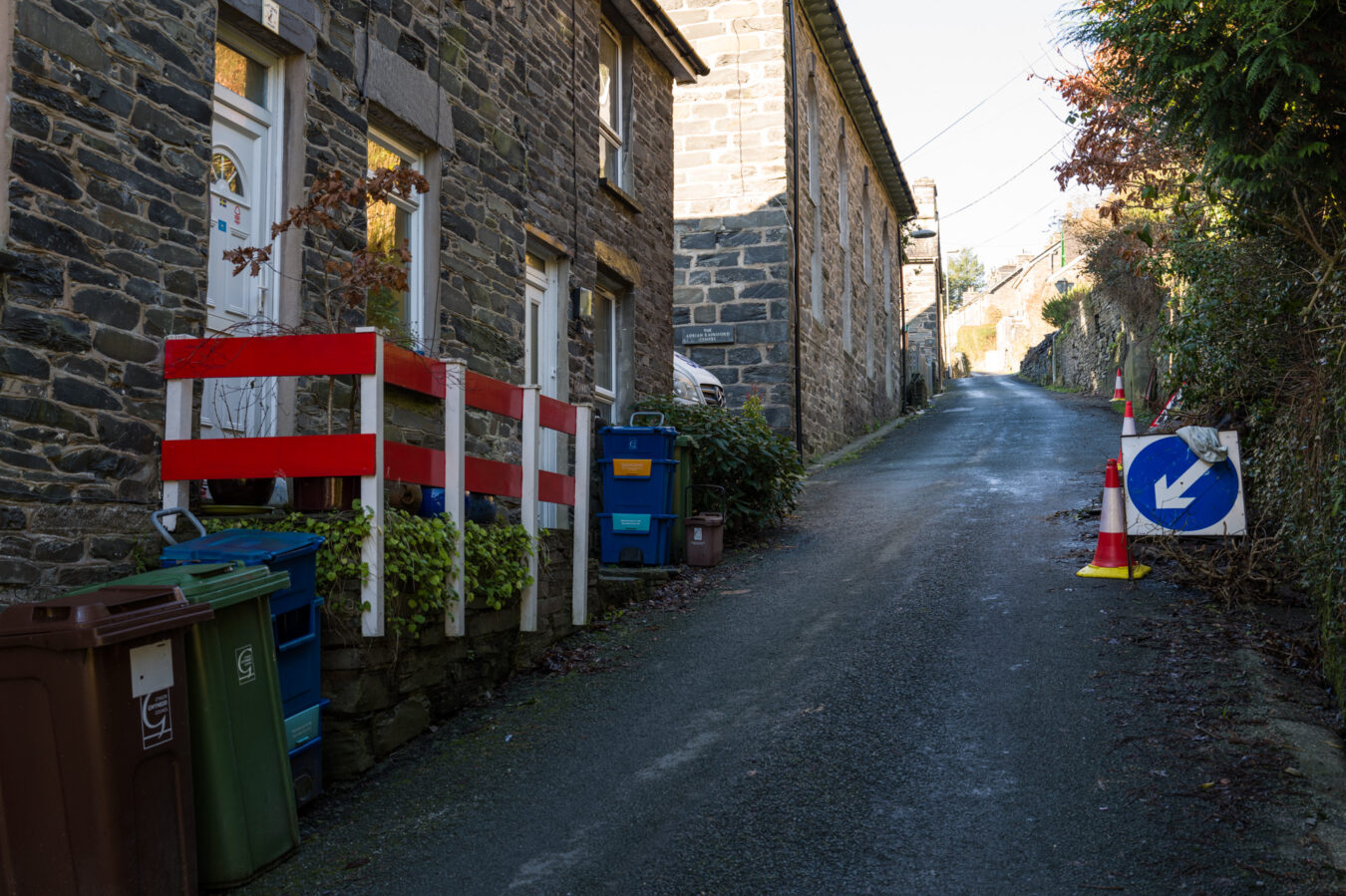
Follow this road for about 500 metres (550 yd), passing cottages and the hostel, until you see a public footpath on the right. The tarmac road now gives way to a dirt and stone trail.
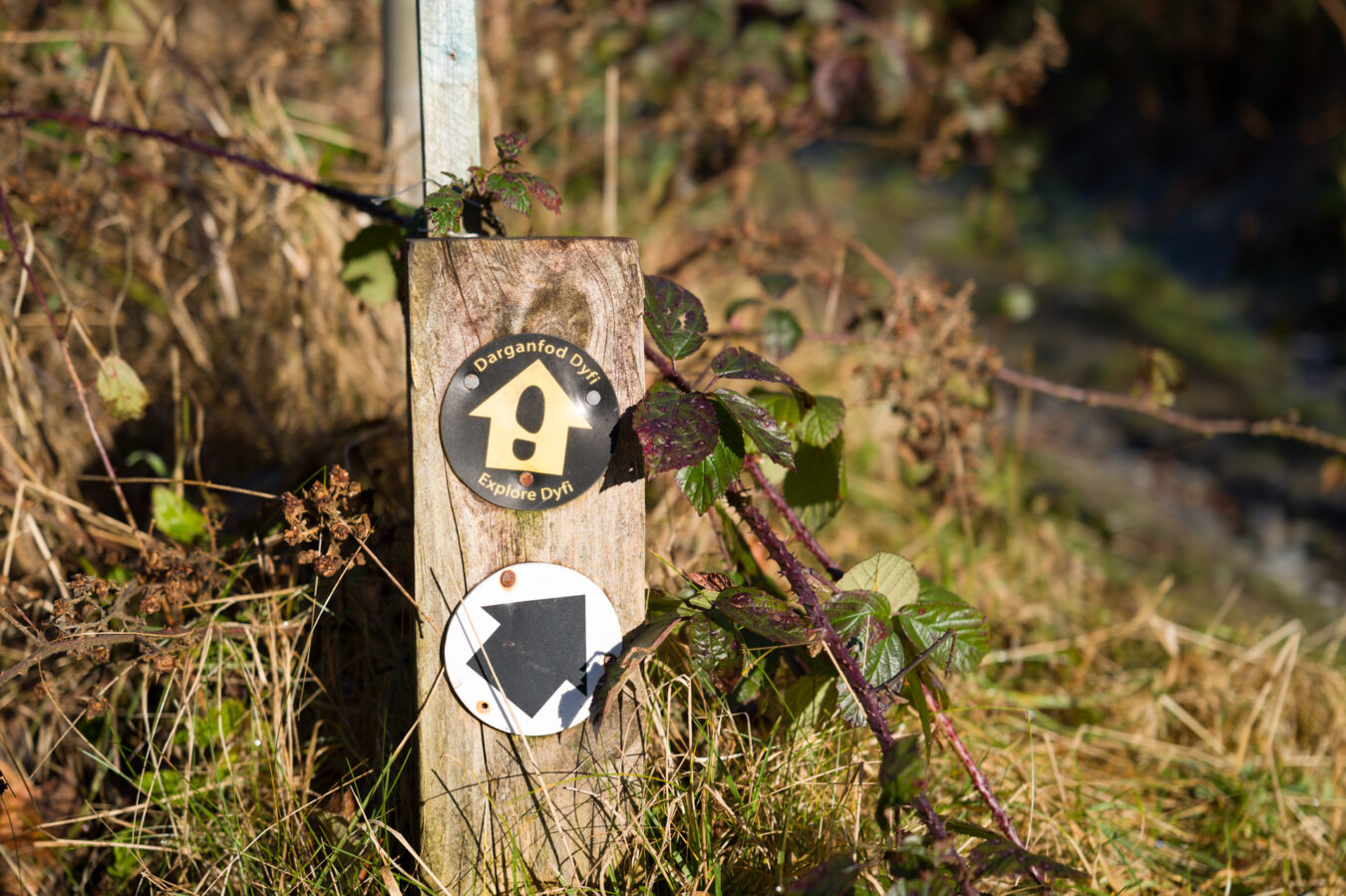
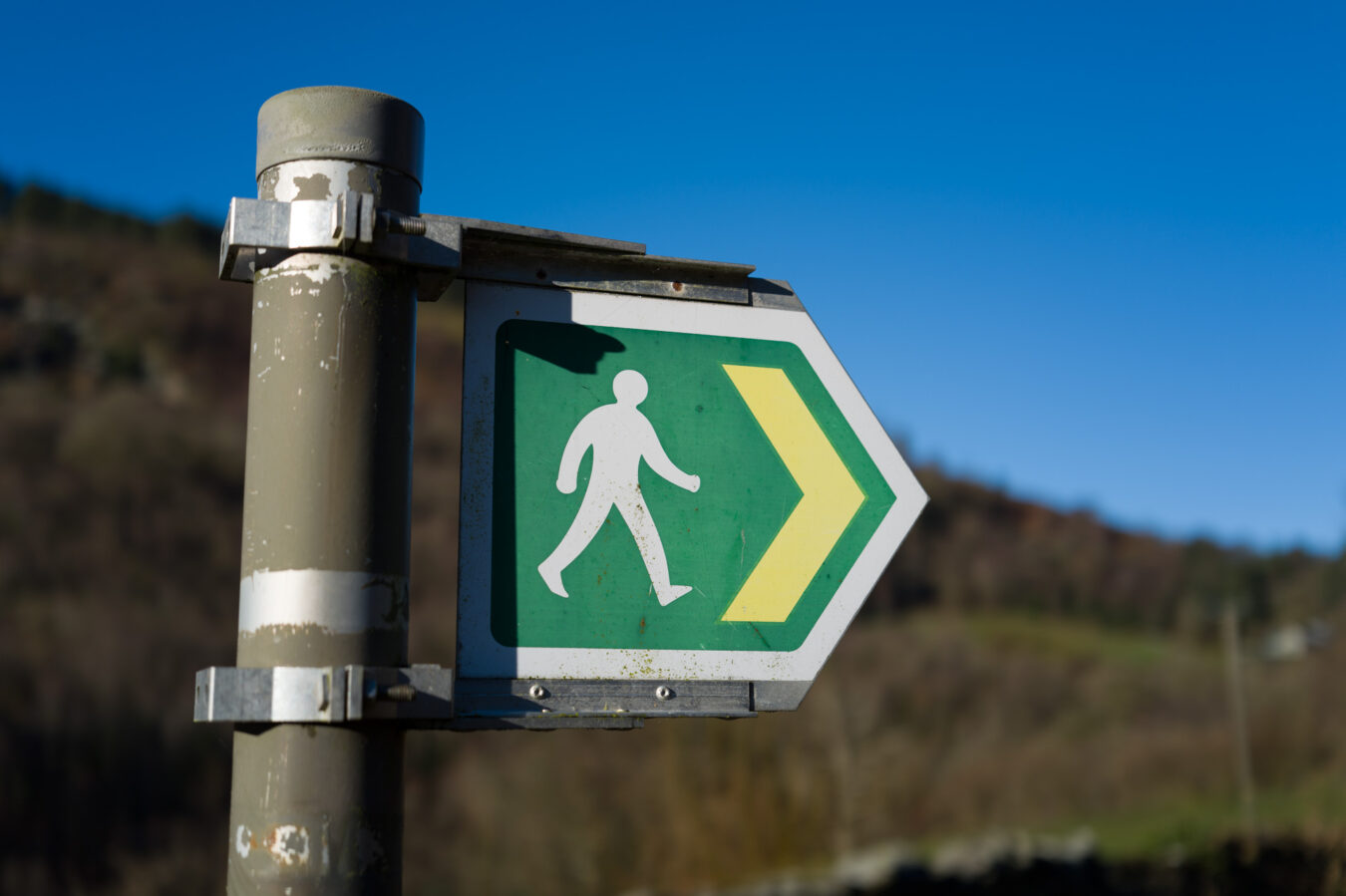
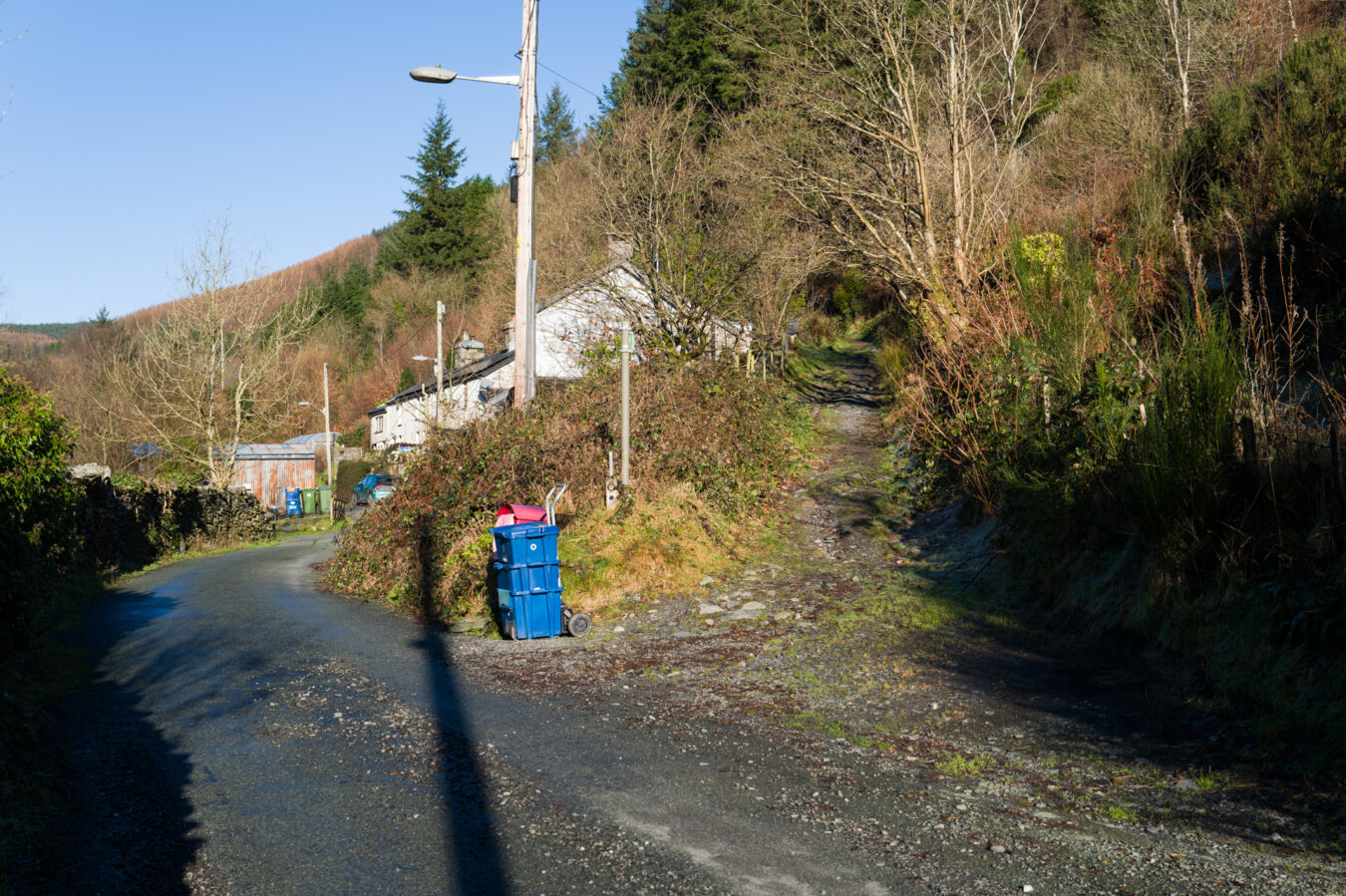
The Ruins of Cwmodyn Quarry (Abercorris)
NOTICE
Shortly after the start of the trail, you’ll pass a cottage on your right which boasts a stunning display of Italian building replicas, which was created by a former local resident. However, please note that the cottage has new owners now and the garden is not open to visitors. A clear sign asks walkers to keep out, so please avoid disturbing the private residents asking to see the garden. You can briefly admire the buildings from the public footpath before resuming the walk. Also, keep your dog on a lead, as free-ranging chickens may be nearby.
Continuing along the path. you’ll be soon surrounded by tall trees on either side as you venture deeper into the Abercorris woodland. Another 430 metres (470 yd) and you’ll reach the top of the walk, where the ruins of the old Cwmodyn Quarry (also known as Abercorris Quarry) are located.
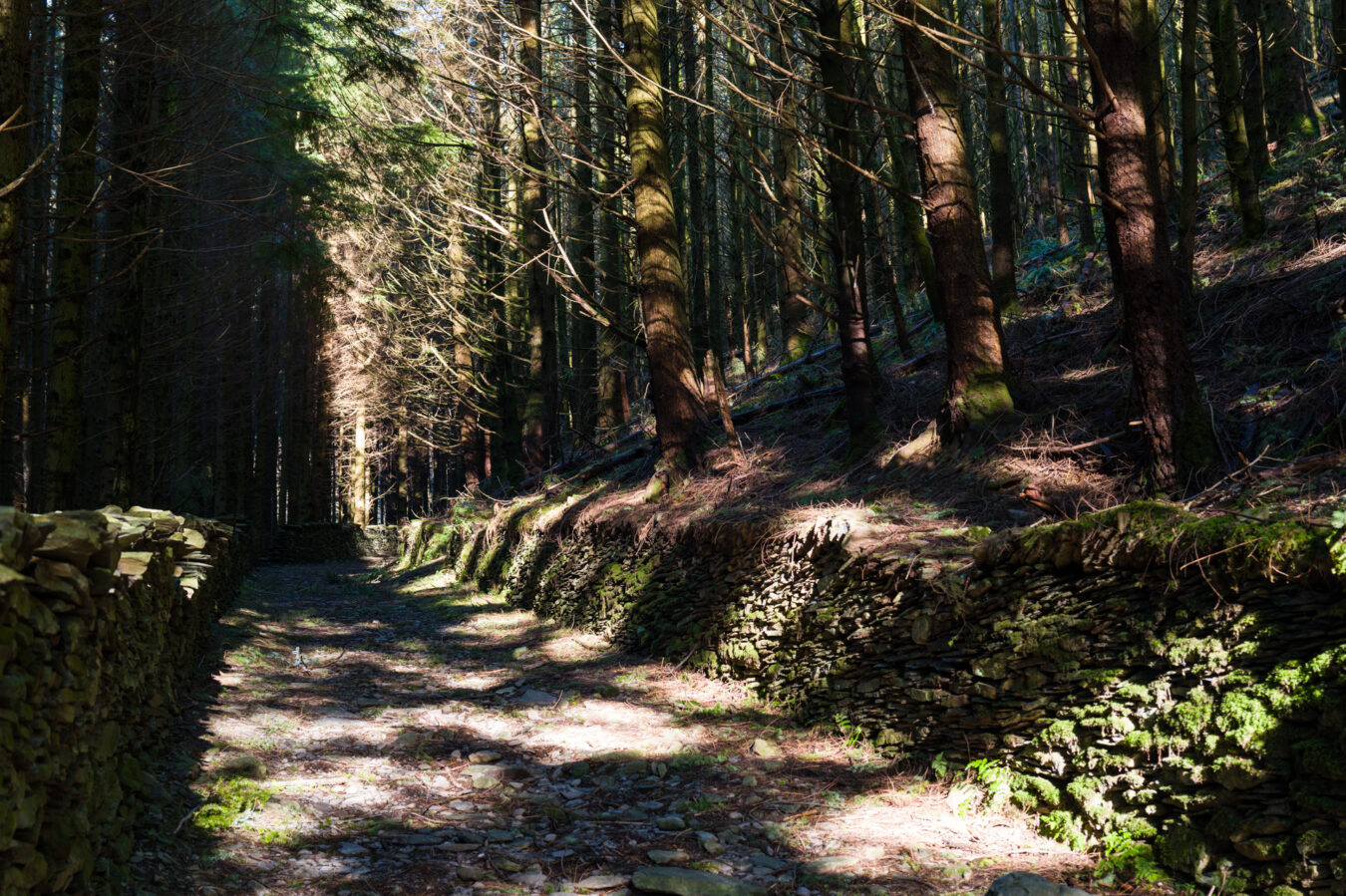
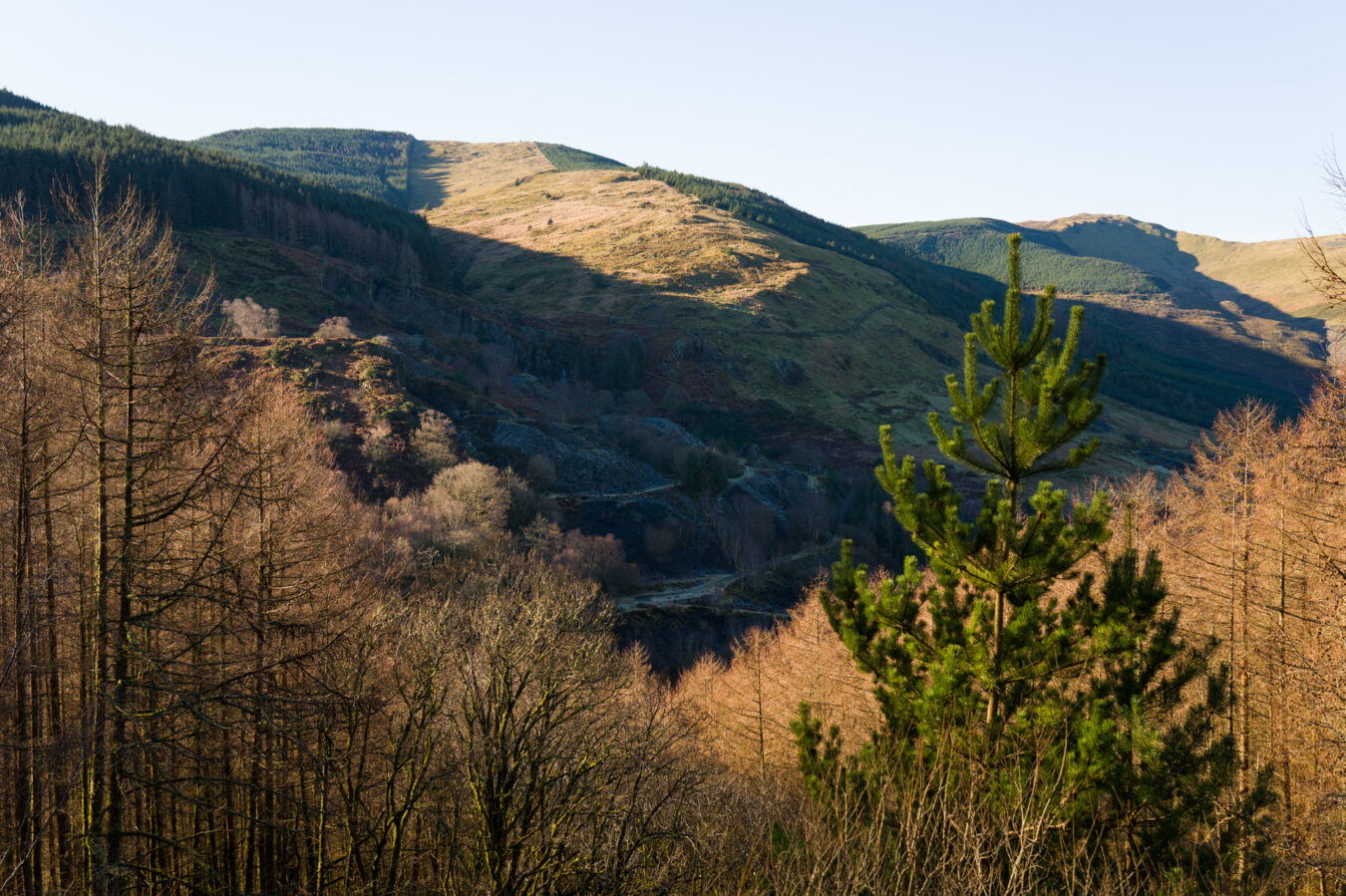
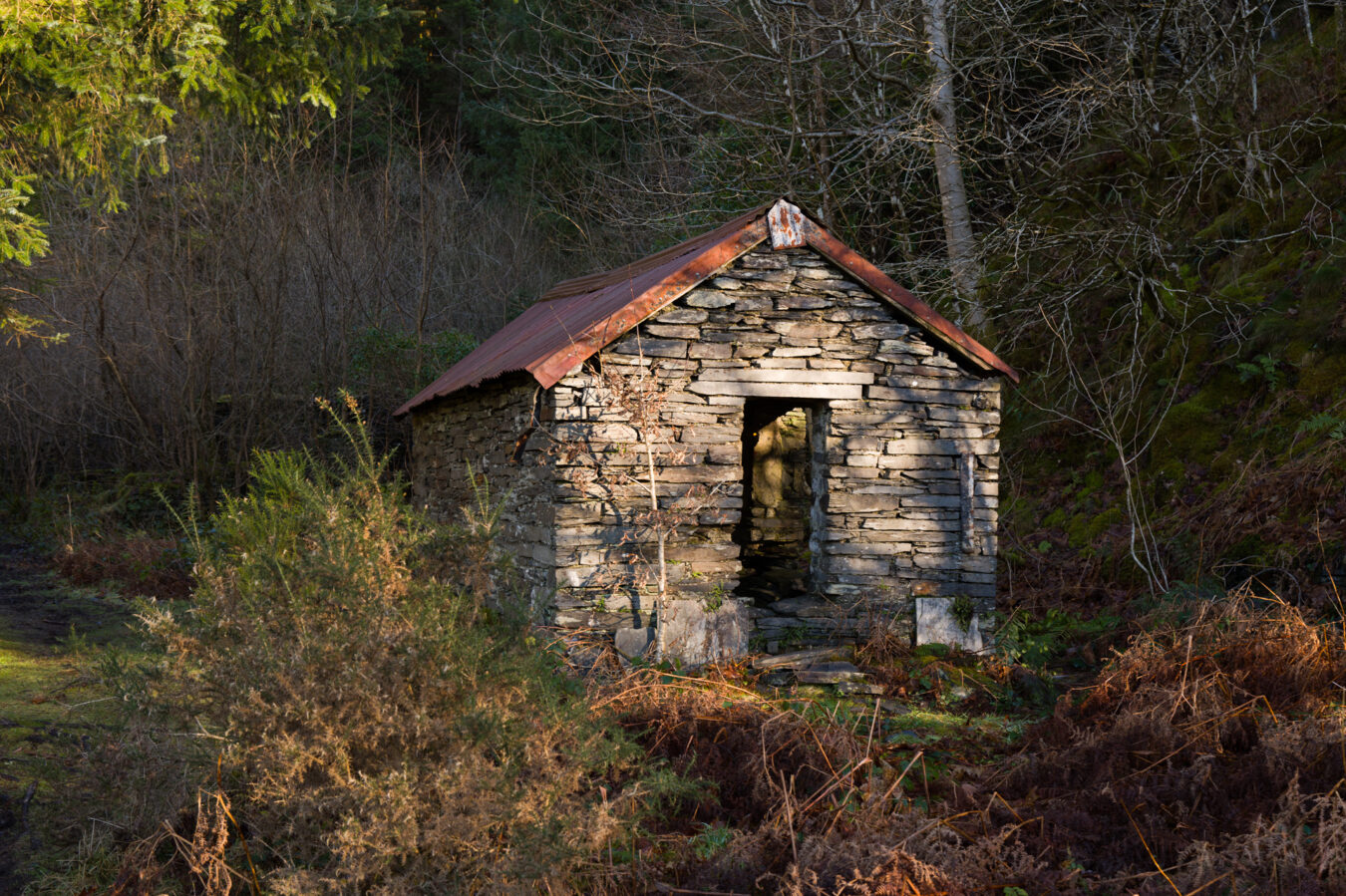
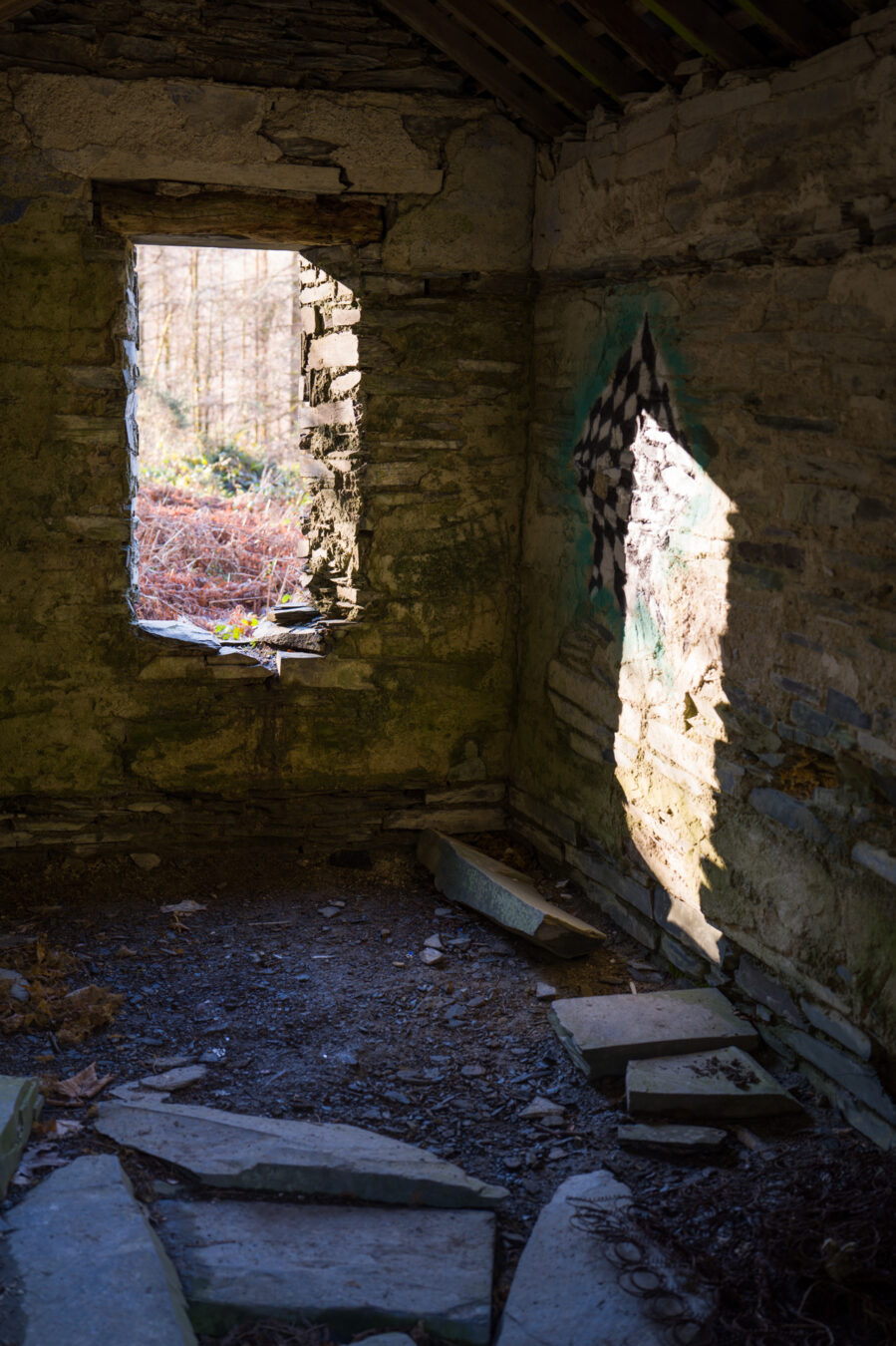
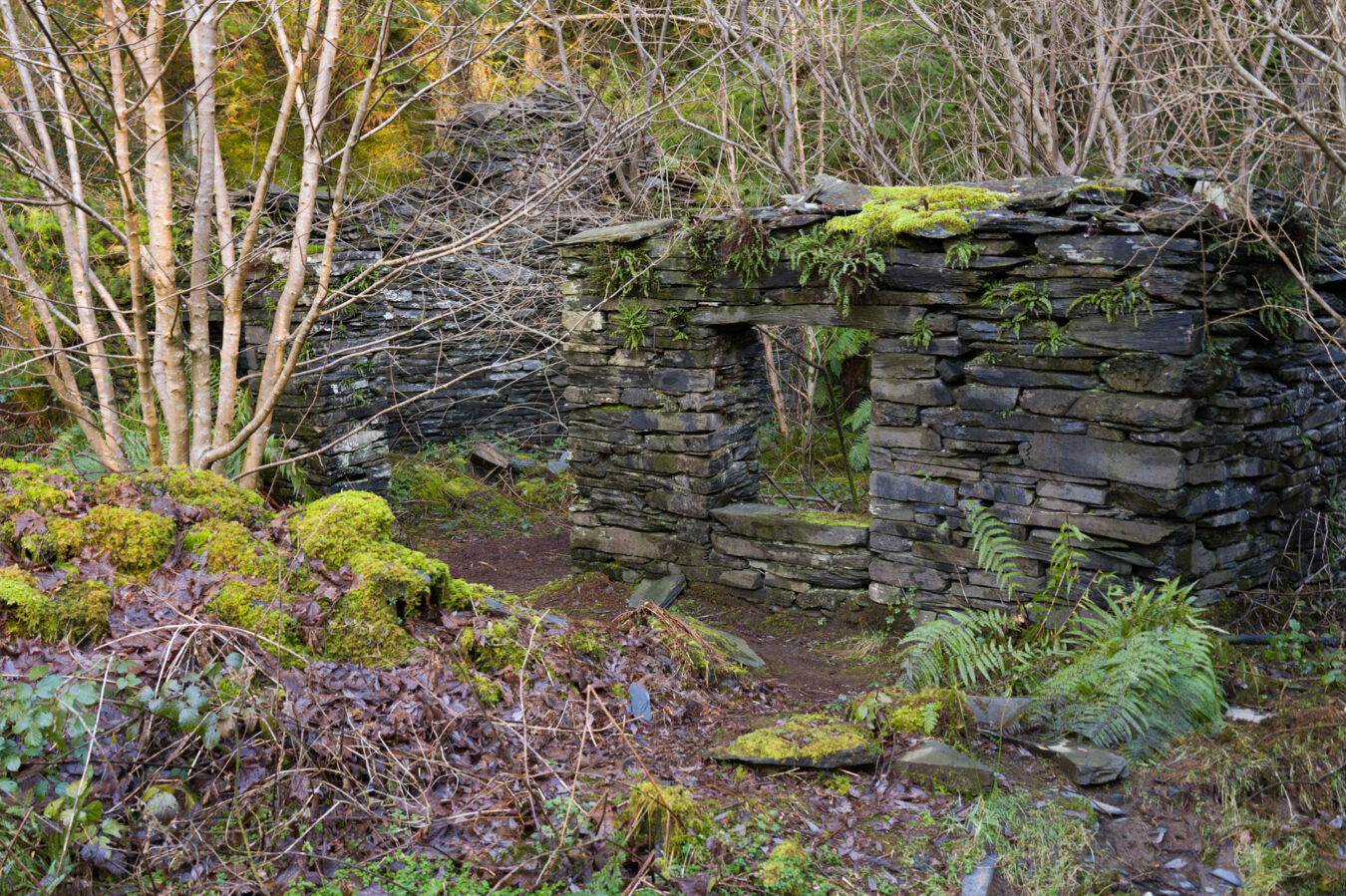

At this point, you’ll enjoy a lovely viewpoint, perfect for admiring the valley and hills ahead. You can explore the old buildings, and you’ll also spot not one, but two small waterfalls. It’s easy to get close to the first waterfall, but the second is farther away. You’ll need to take extra care, as the path is narrow, steep, and can be slippery when wet.
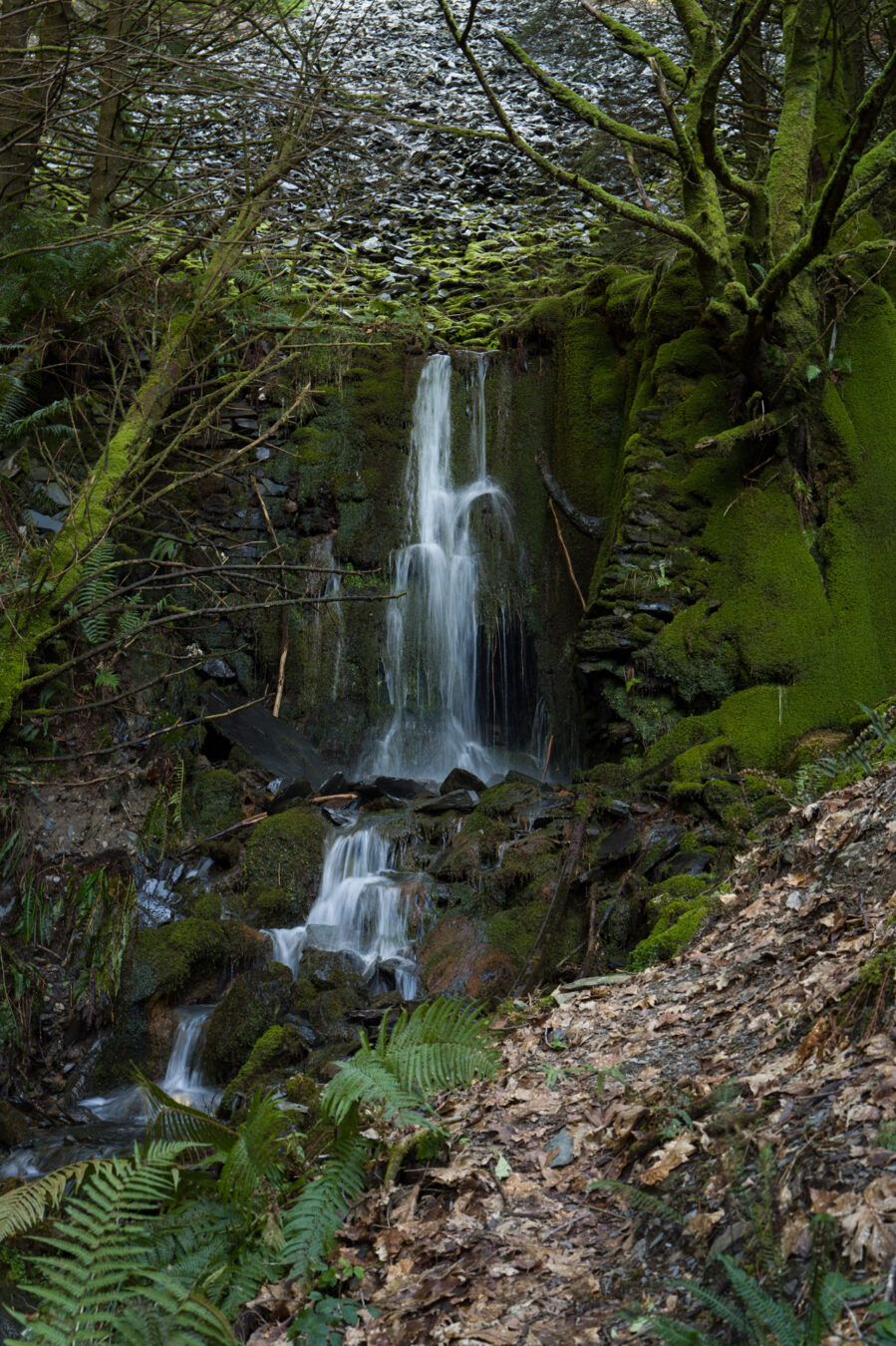
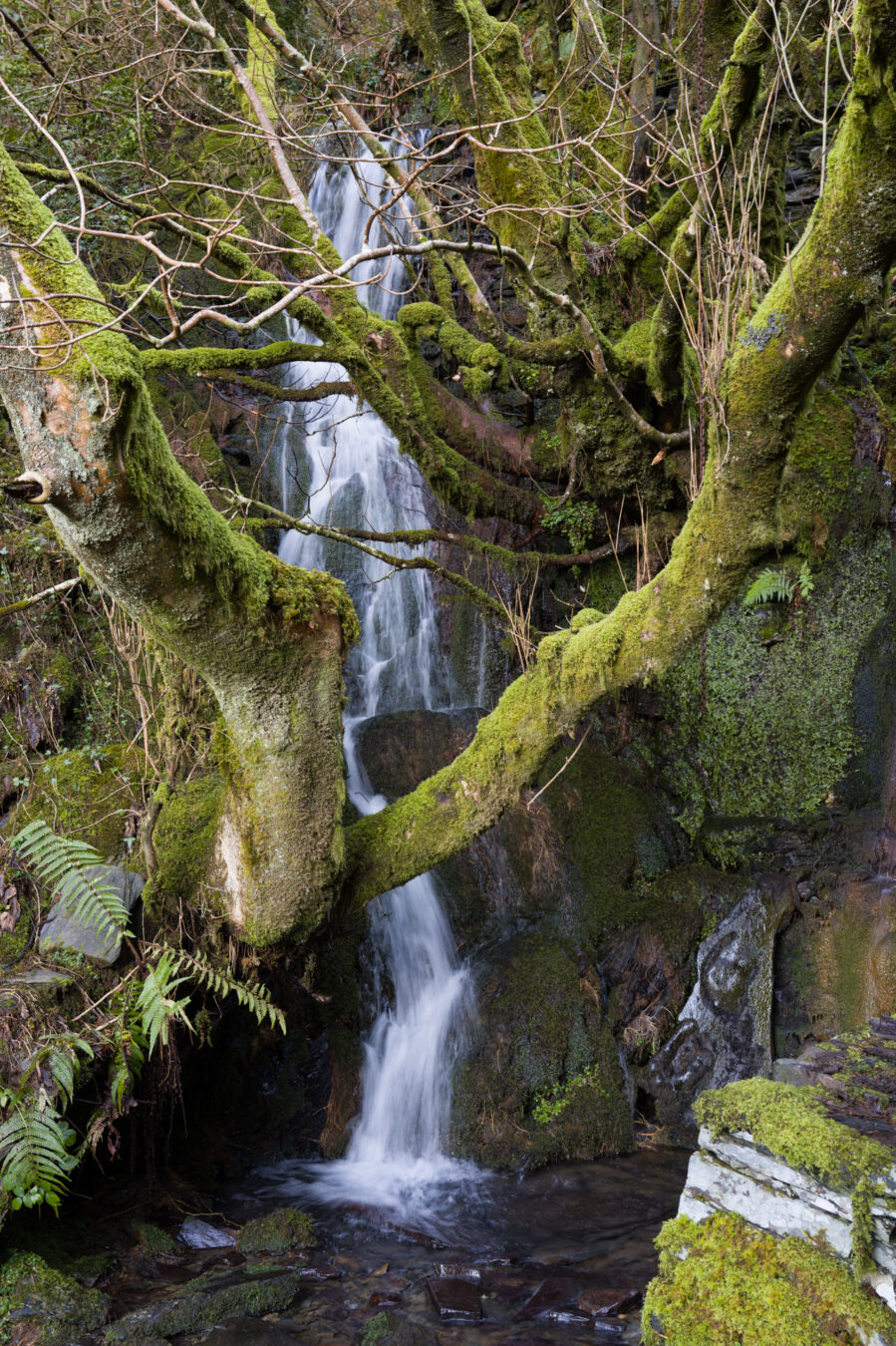
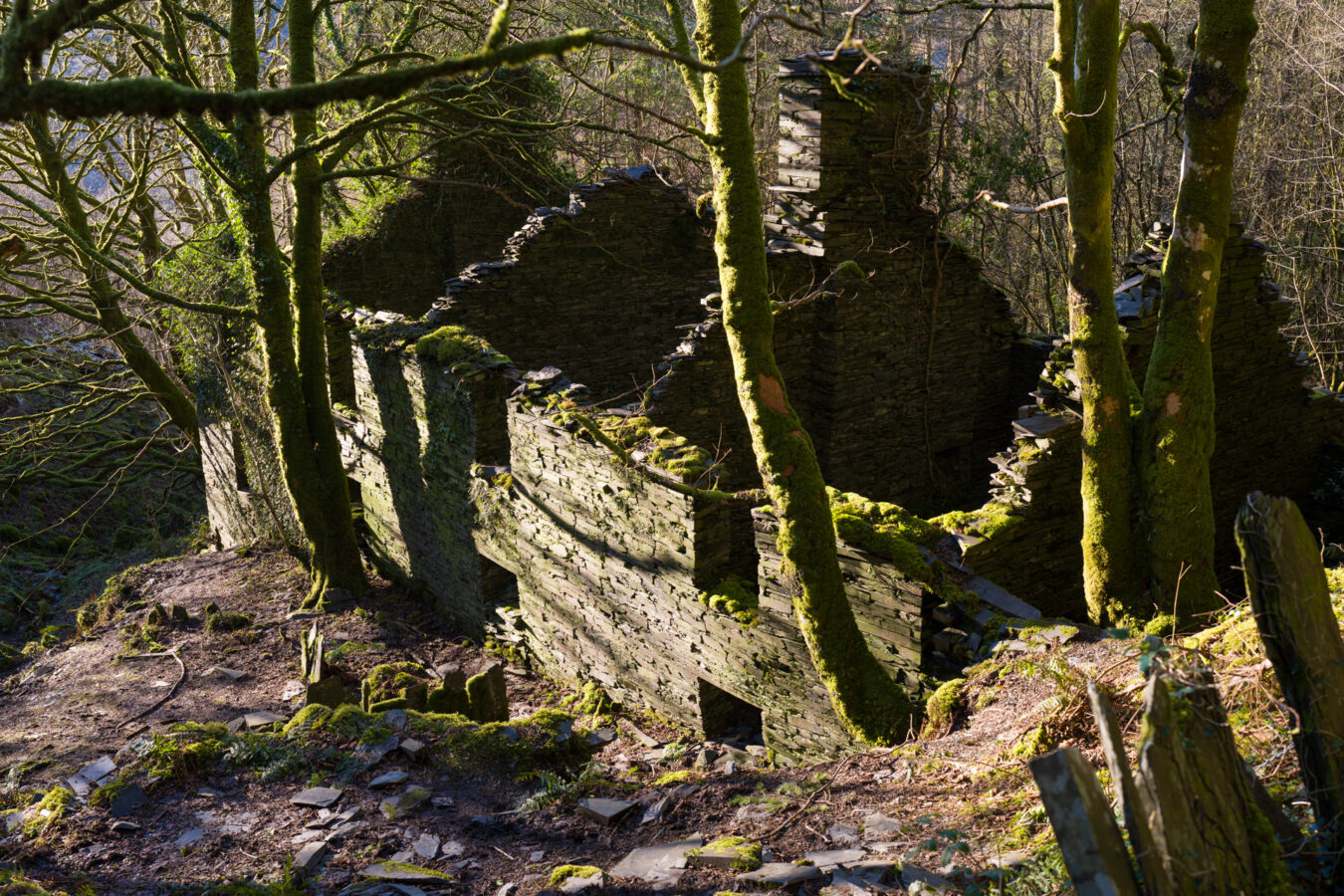
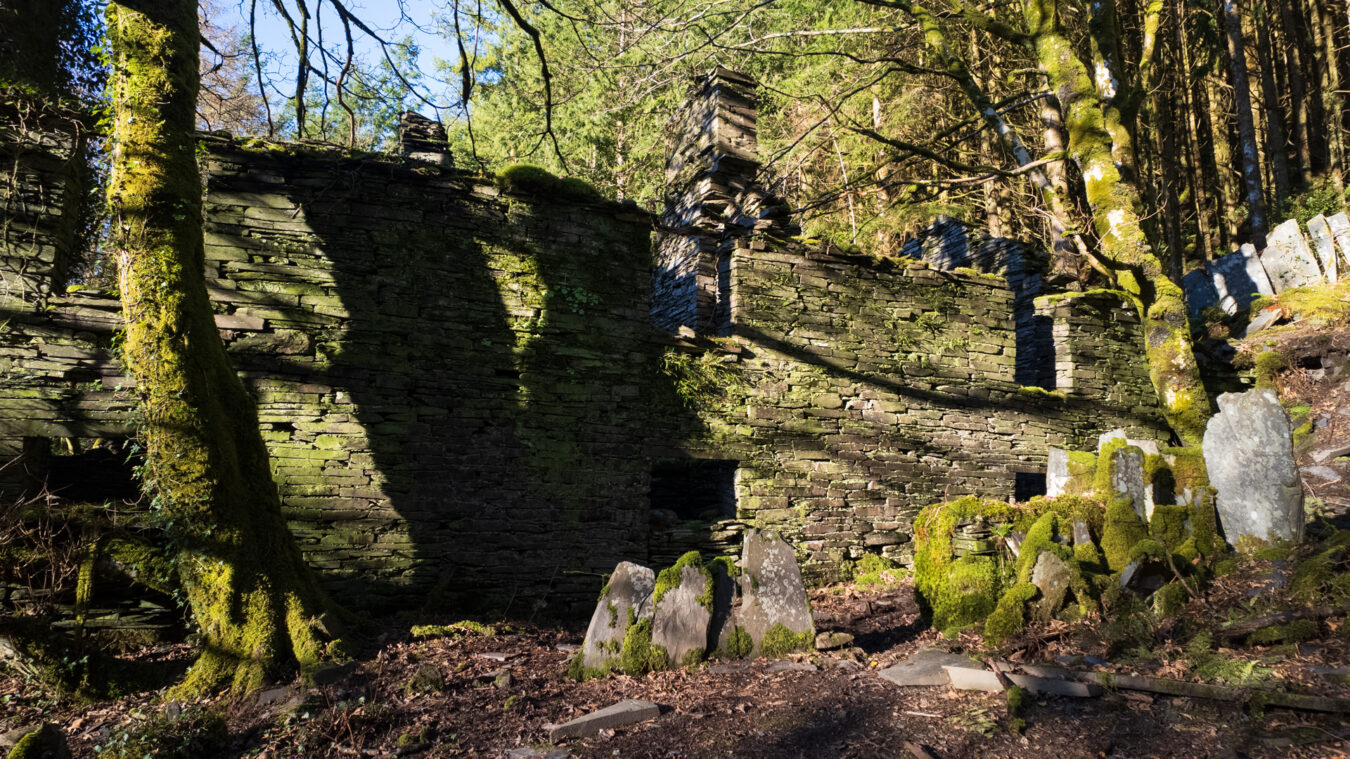
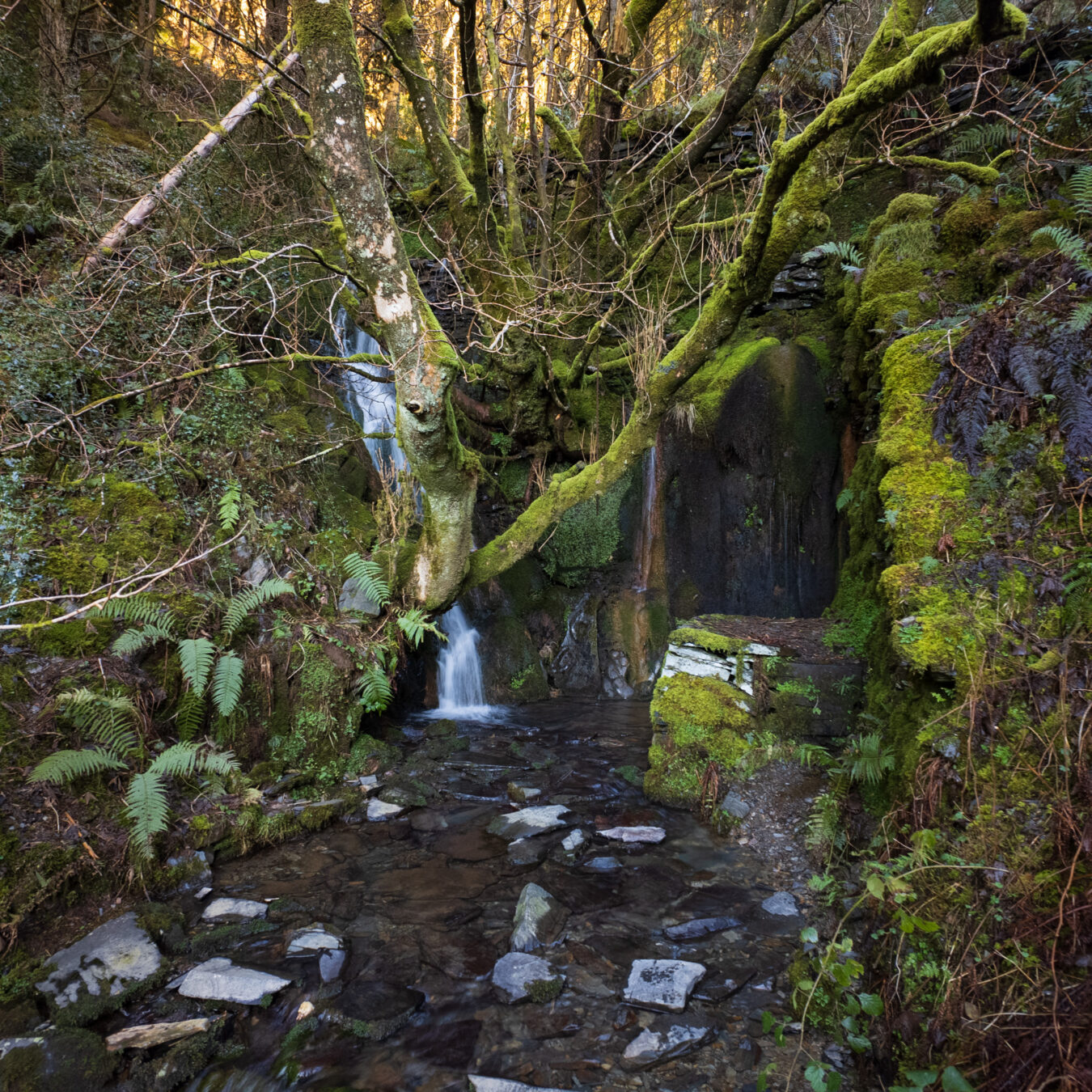
Cwmodyn quarry
- The quarry was in operation between 1860 and the early 1950s.
- The remnants of the buildings include a slate mill, workers’ cottages, and a canteen.
- Quarrymen working here often engaged in debates and recited poetry during their breaks.
The Binocular Tunnel (Abercwmeiddaw Quarry)
After passing the largest ruin of the quarry, the path will lead you down through another section of woodland, before emerging onto a large, sloping field. Signs will guide you as you continue walking downhill, passing a couple of gates until you reach a tarmac road.
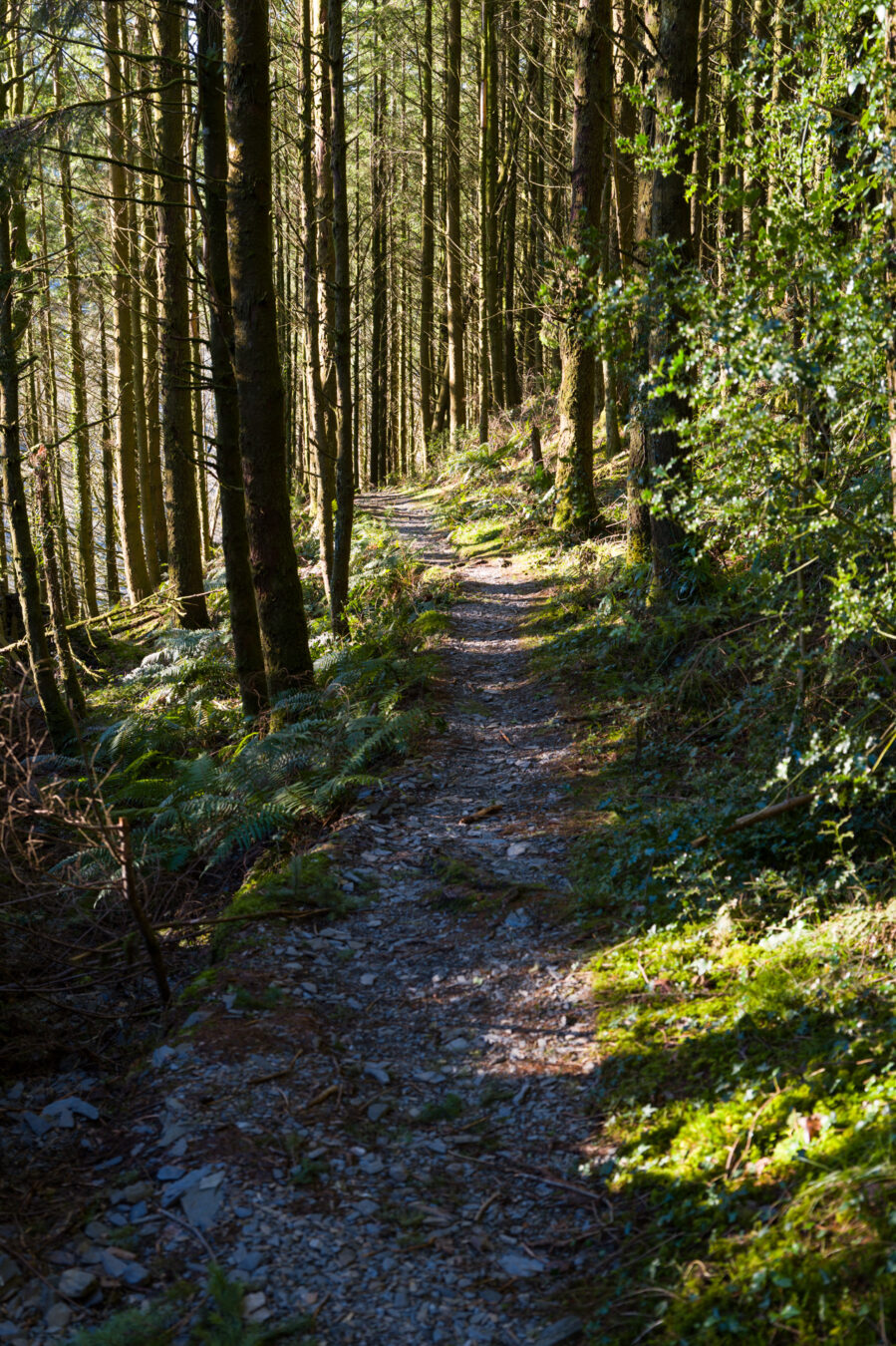
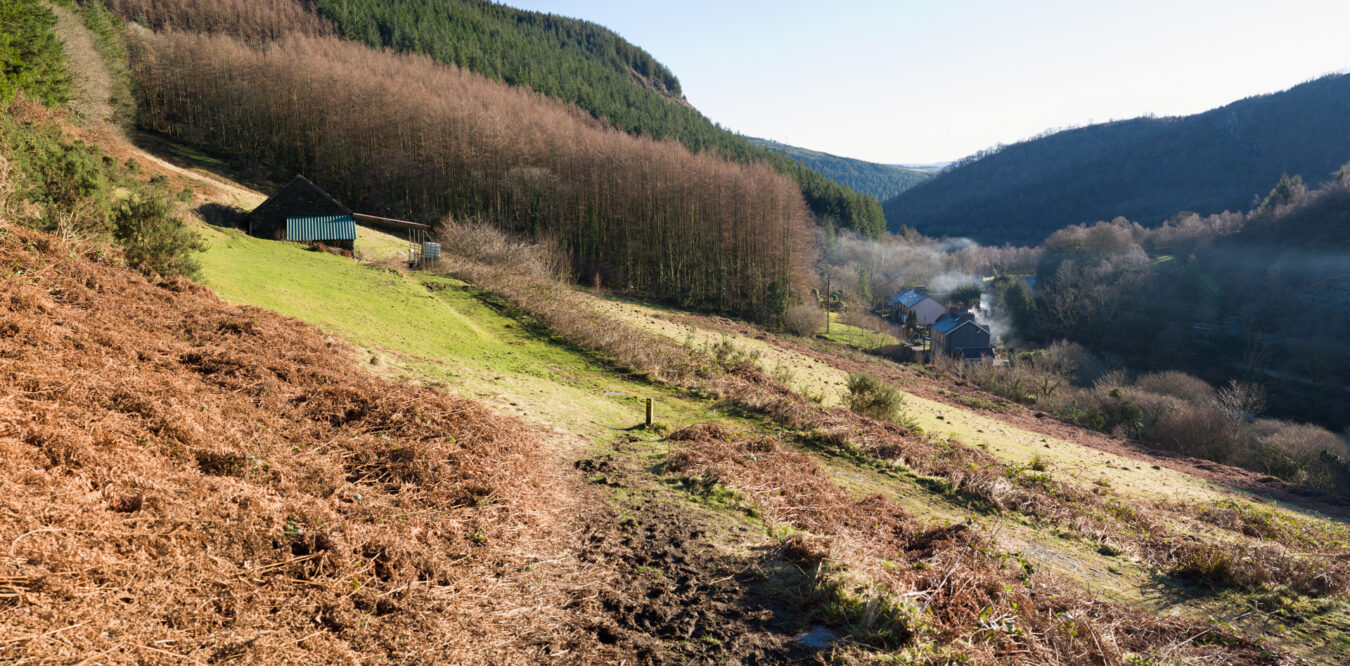
If you turn left, you’ll head back to the village. Instead, go right — there’s something nearby you won’t want to miss! Walk for about 100 metres until you see a bench on your right and a large metal gate further behind. The gate is locked, but there’s enough space for one person to pass through on the left side, between the gate and the wall.
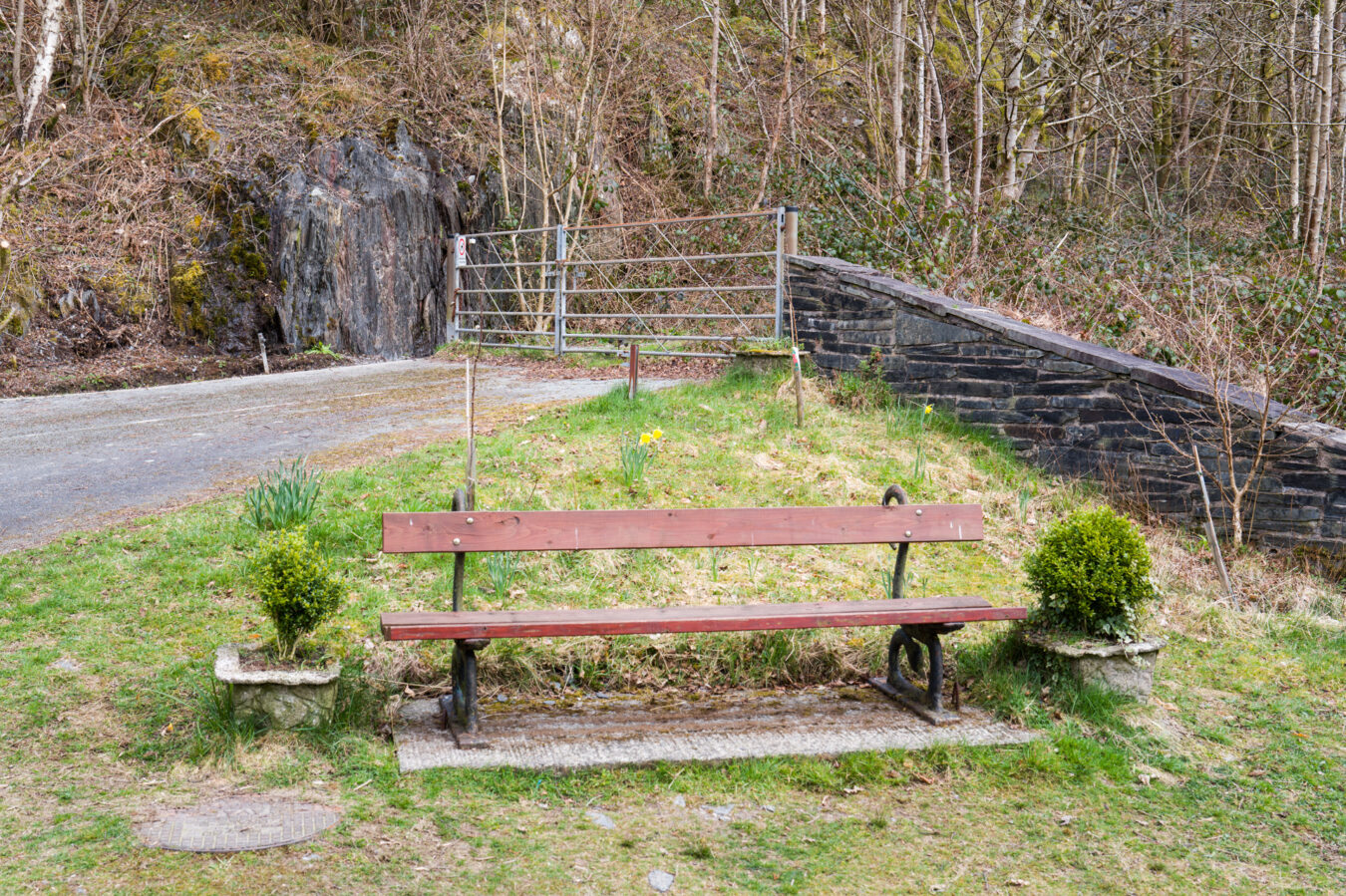
From here, simply follow the dirt road for about 600 metres as it winds northwards. You’ll pass more ruins along the way (don’t try to go inside, as they are marked as unsafe) and a few benches where you can rest.
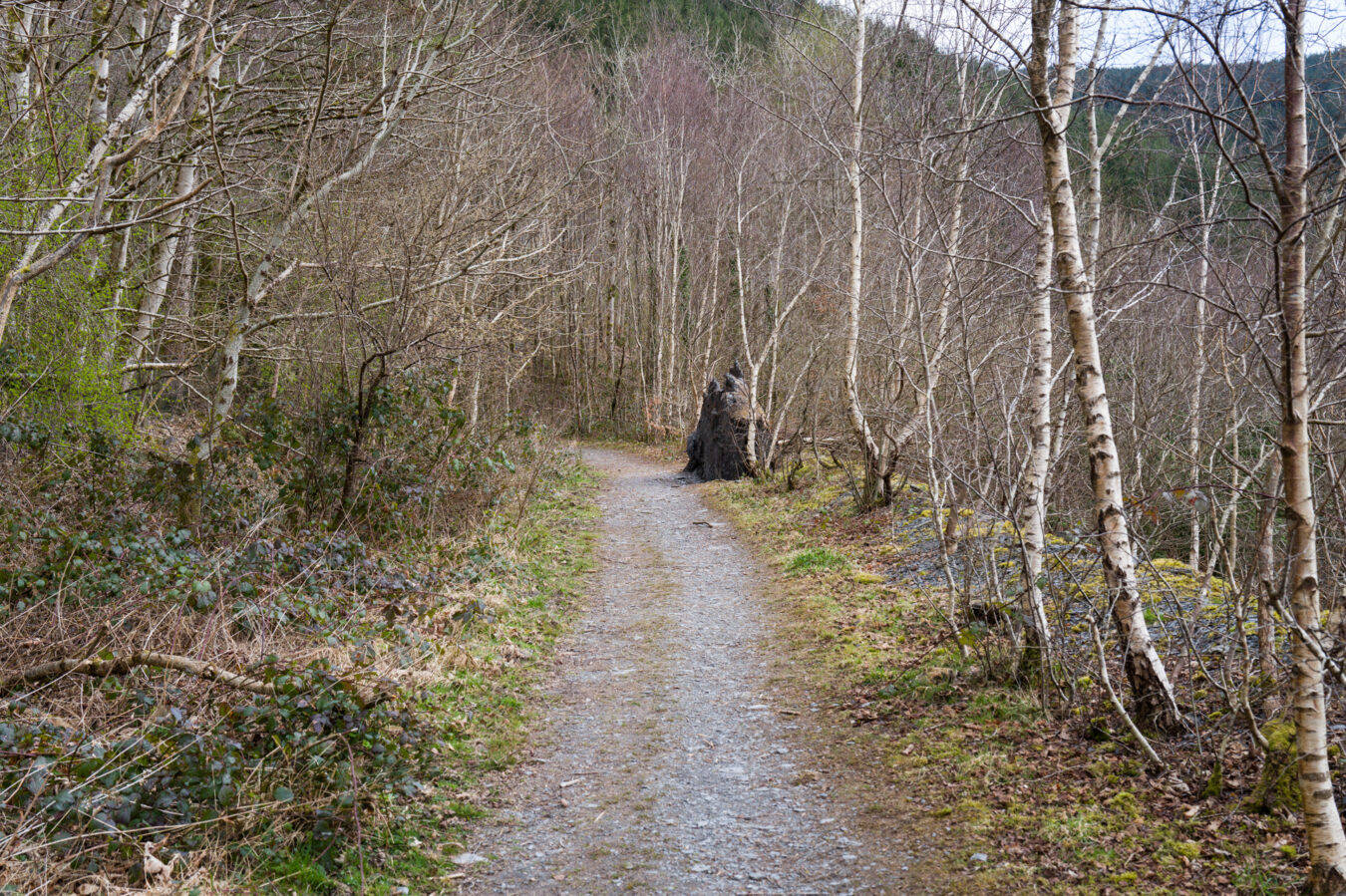
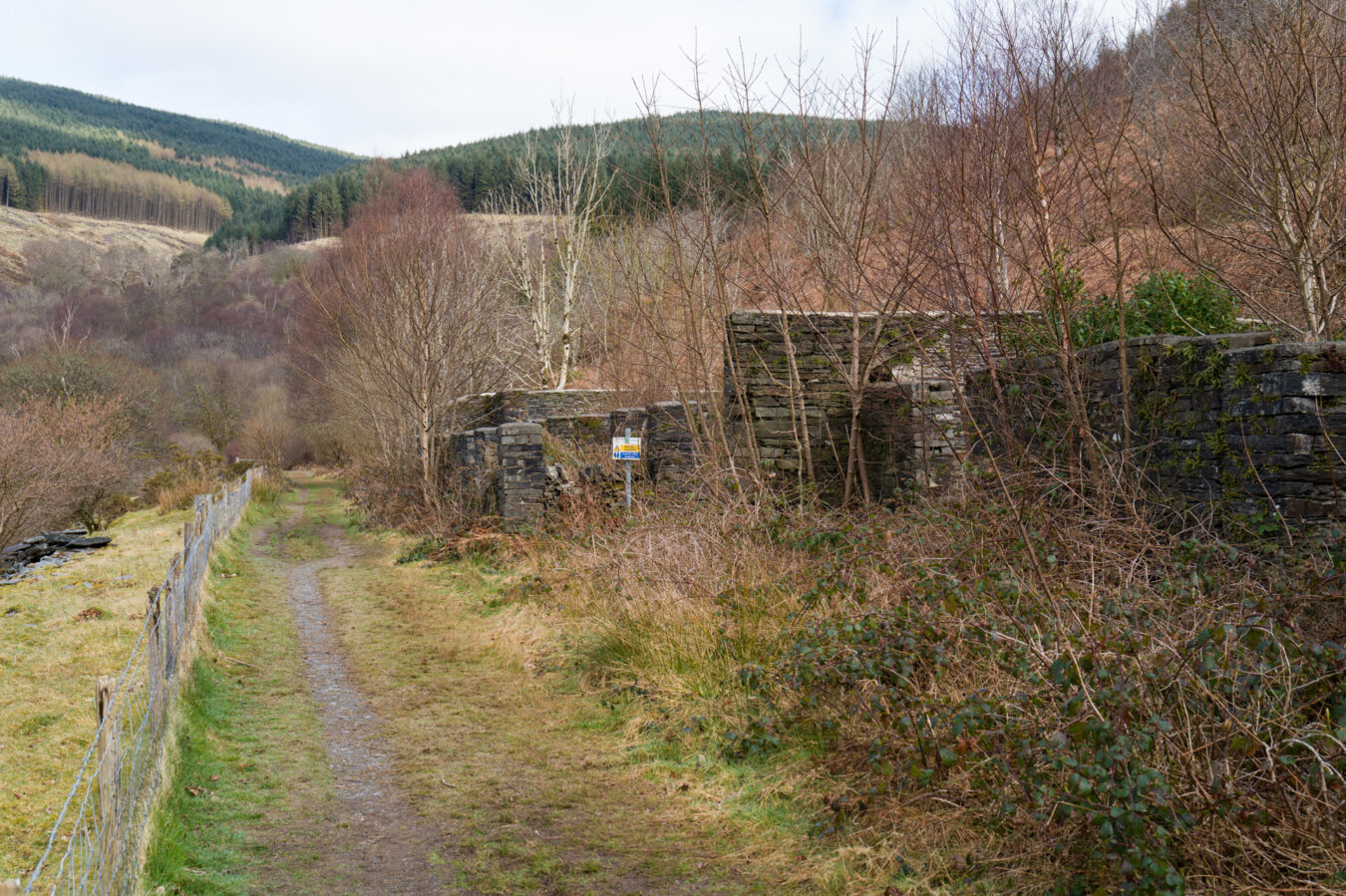
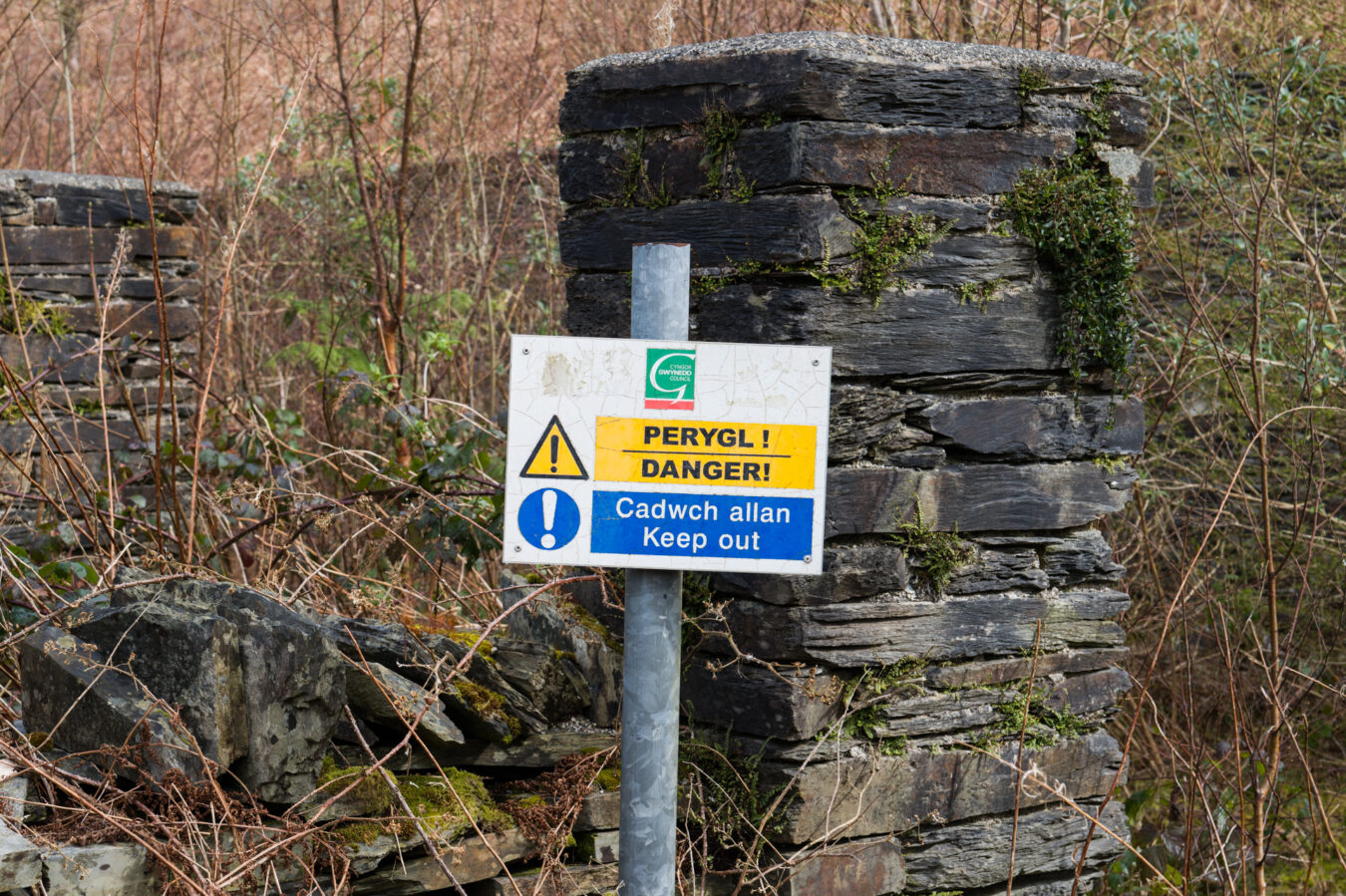
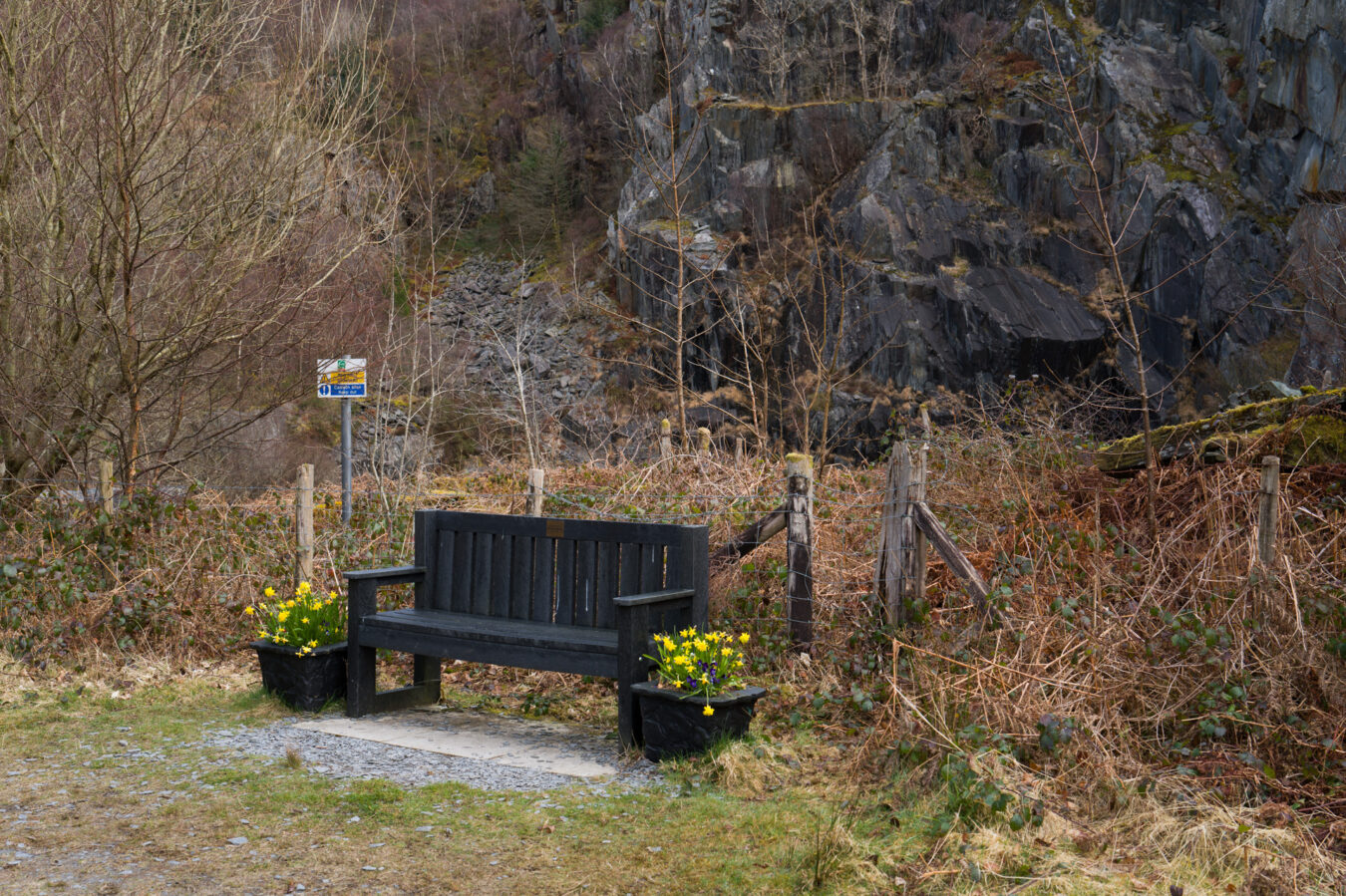
The large quarry hole on your right will start to come into view before you arrive at a fork — take the right path and walk downhill. In the distance, you’ll see a curious tunnel in the shape of a pair of binoculars. Once at the bottom, there’s a small patch of water and a small cave with a low tunnel on the left.
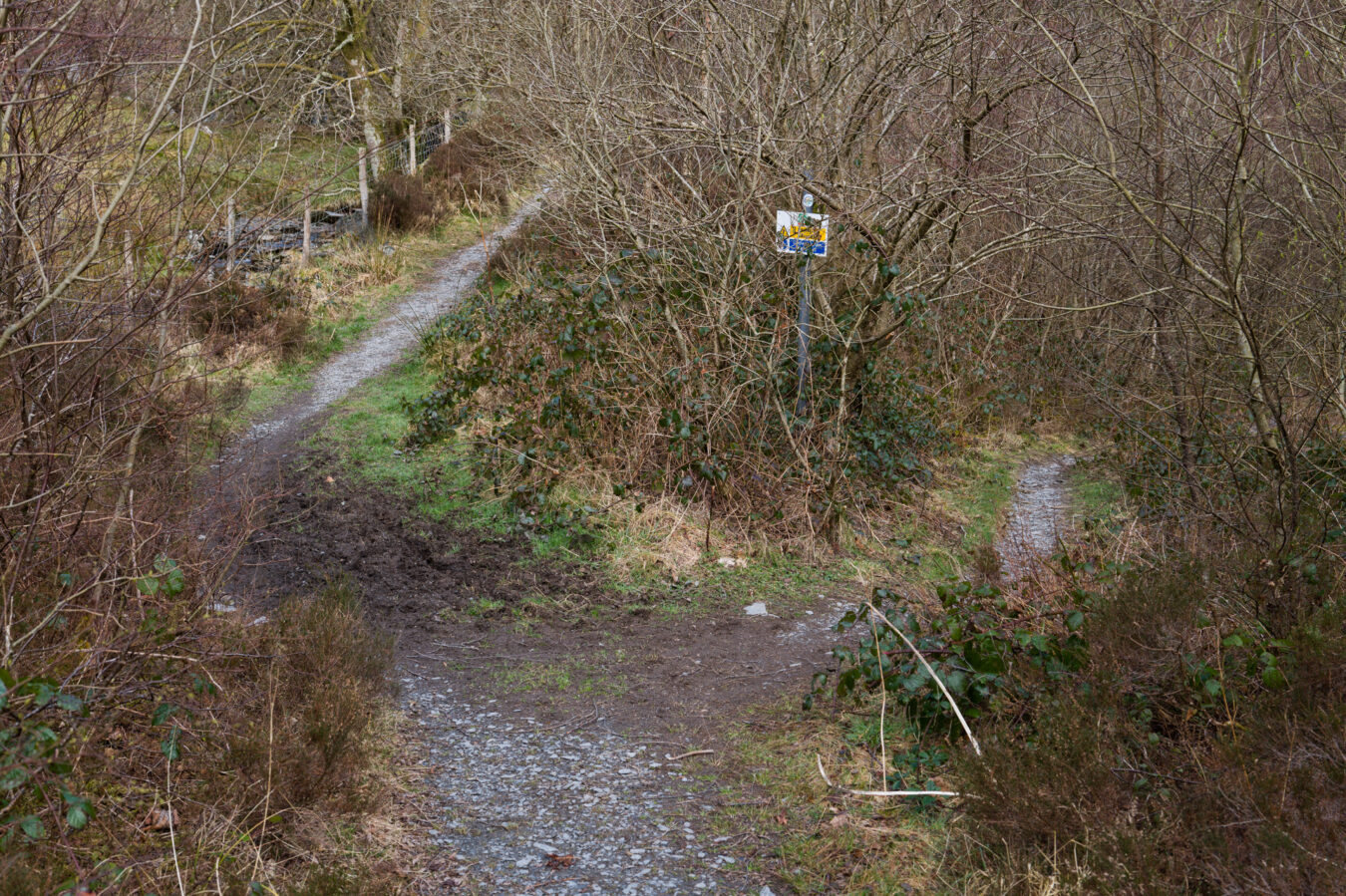
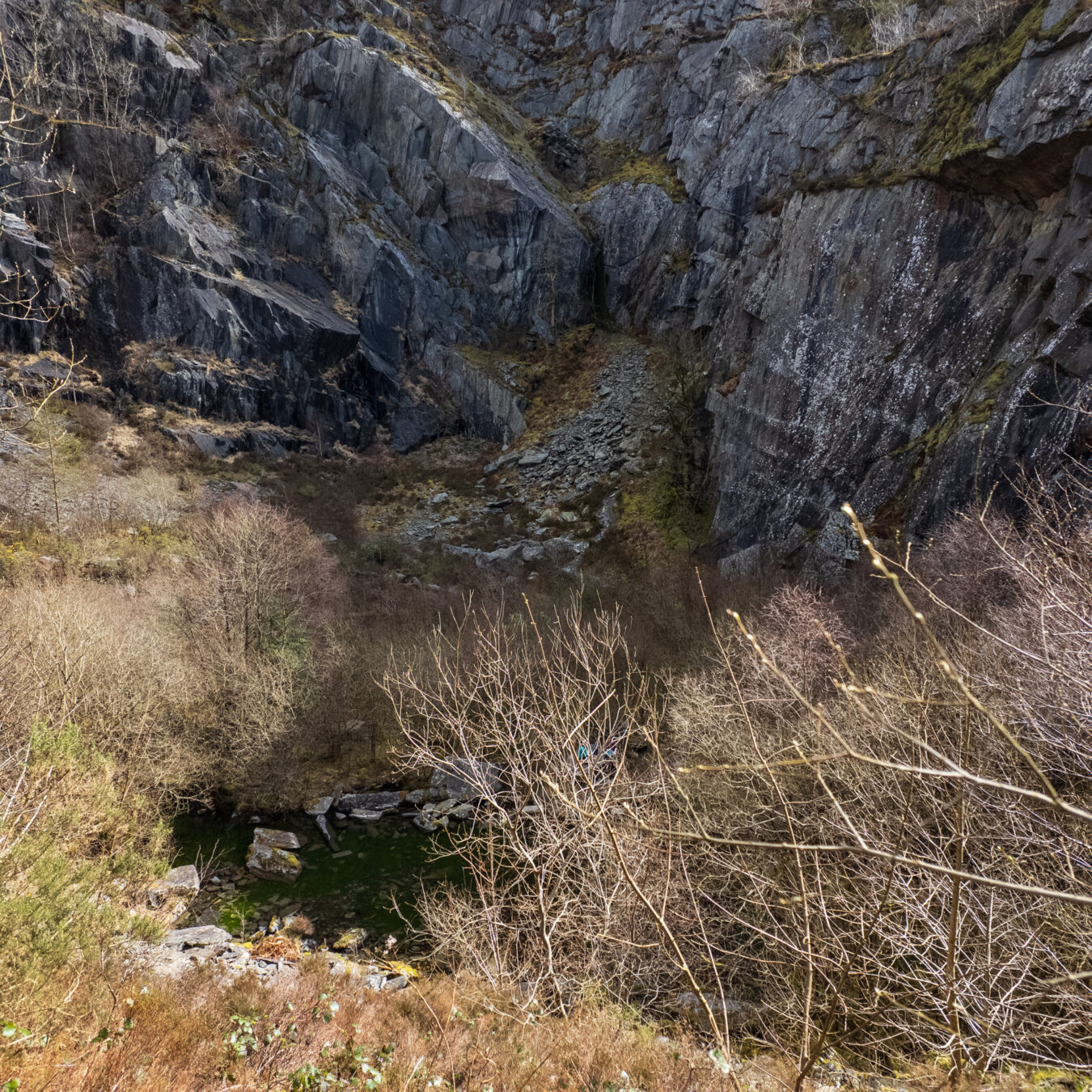
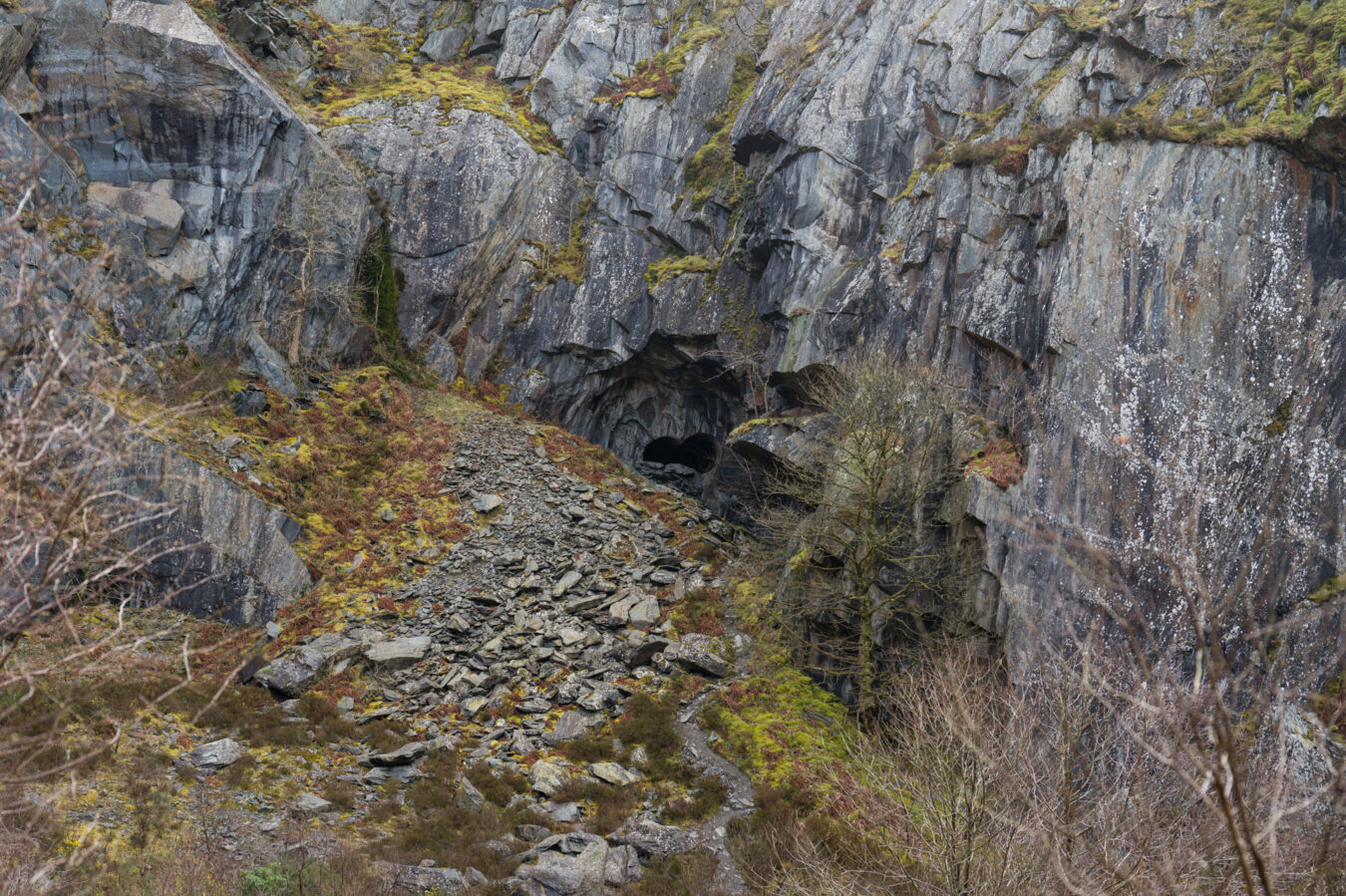

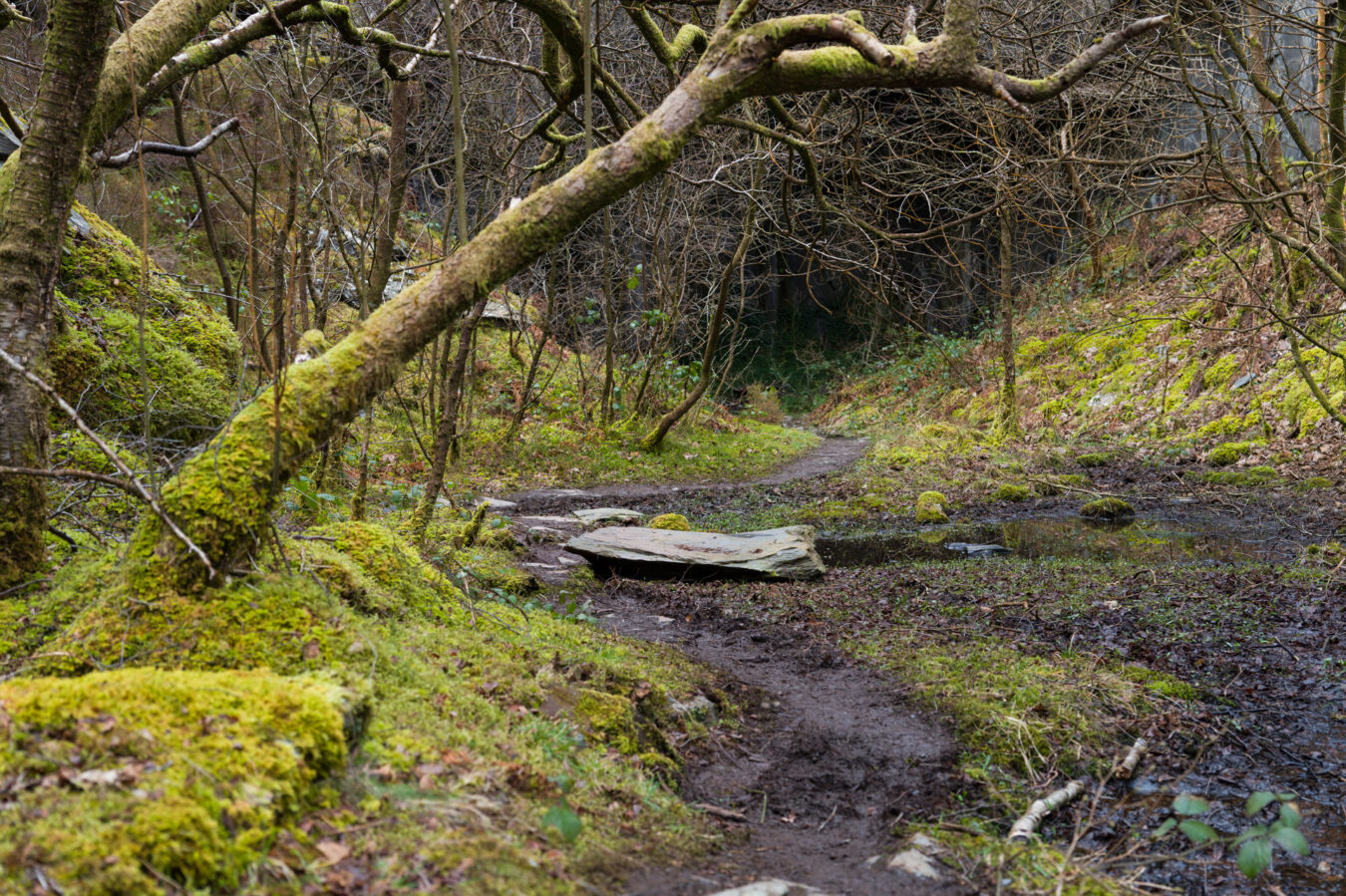
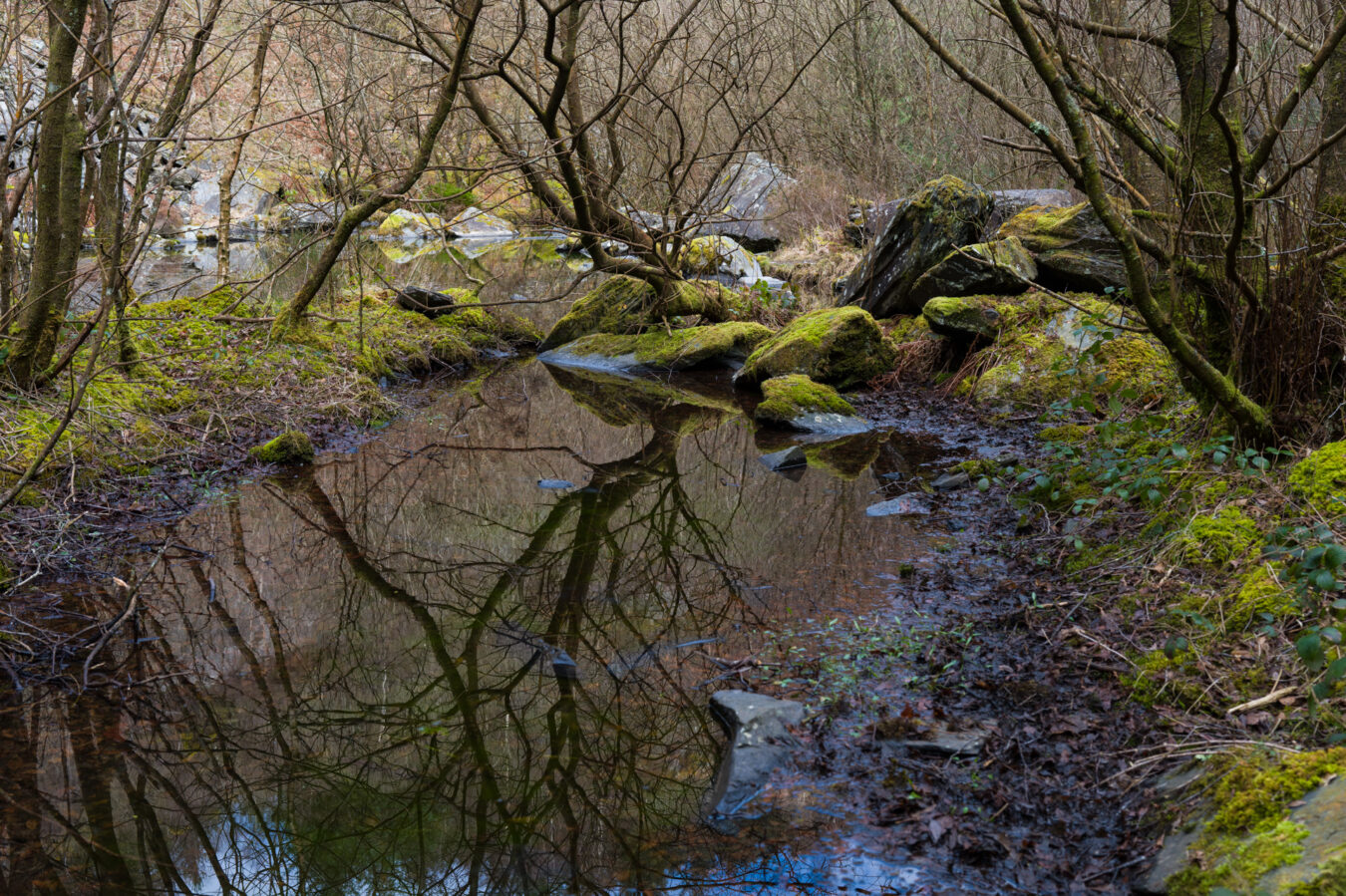
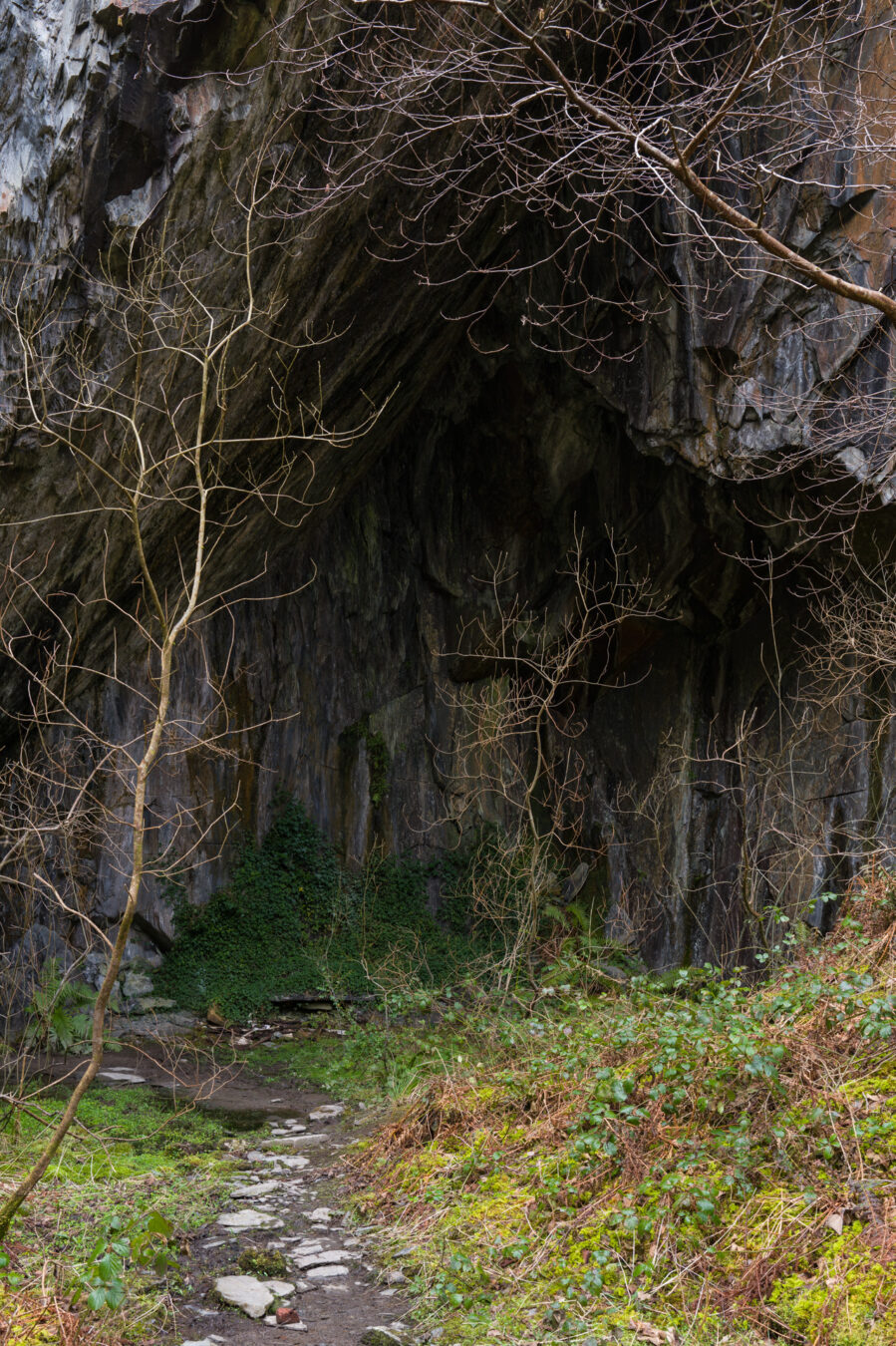
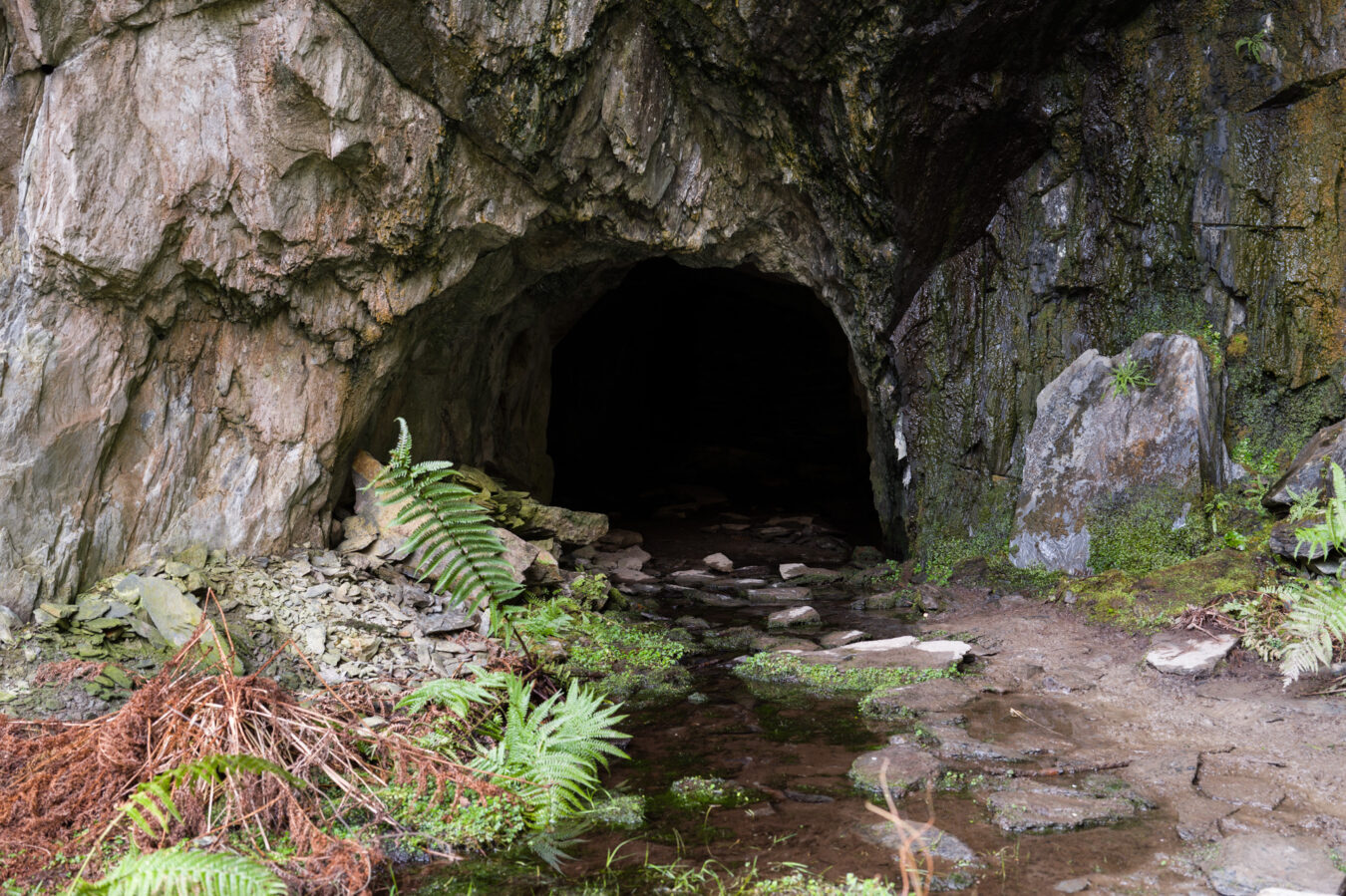
the binocular tunnel
These curious twin tunnels, shaped like binoculars, were cut by one of the world’s first boring machines, designed by Scottish engineer George Hunter. Various versions of these steam-powered tunnelling machines were trialled in North Wales during the mid-1860s. Despite showing promise, the process was slow, as the machine had to be withdrawn frequently to extract the core.
One proposed solution was to cut two tunnels in parallel. After completing one bore, the machine would be moved to the adjacent rock face to dig a second, intersecting bore cut — allowing the machine to remain in constant use. This trial was carried out at Abercwmeiddaw in 1864, resulting in the bizarre twin tunnels you can still see today, which extend about 30 metres into the rock. Additional trials involving three and even four parallel tunnels were also undertaken at other locations.
Alas, in the end, the engineering process was no match for the efficiency of low-paid miners equipped only with jumper sticks, hammers, and gunpowder. The high costs associated with the machines proved unsustainable, and the project was eventually abandoned. You can read more about this on North Wales Live.
You can get closer to the binocular tunnel by climbing the slope — just take extra care, as it’s somewhat unstable and can be very slippery when wet. You’ll also notice another section of the tunnel on the opposite cliff face.
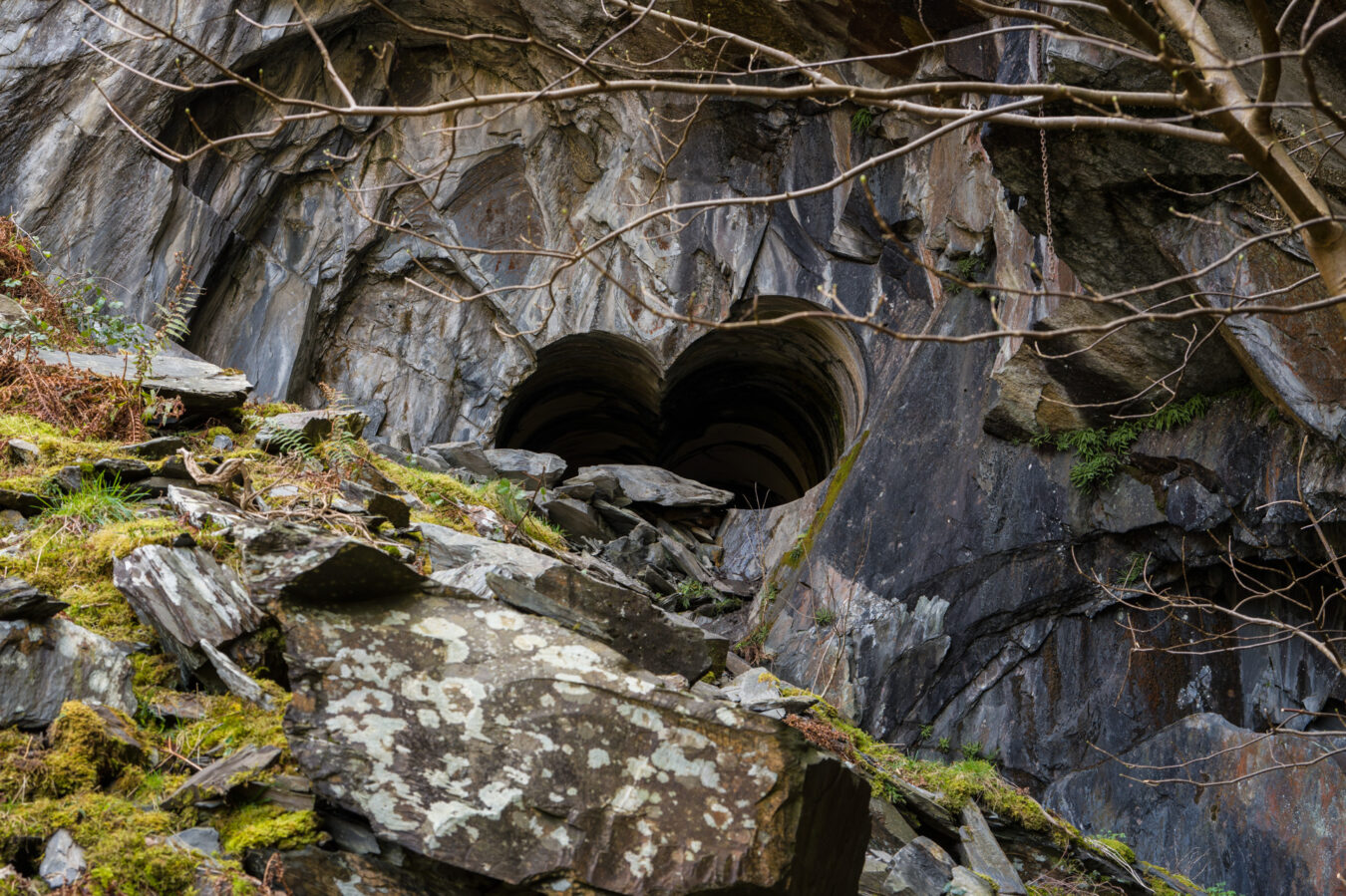
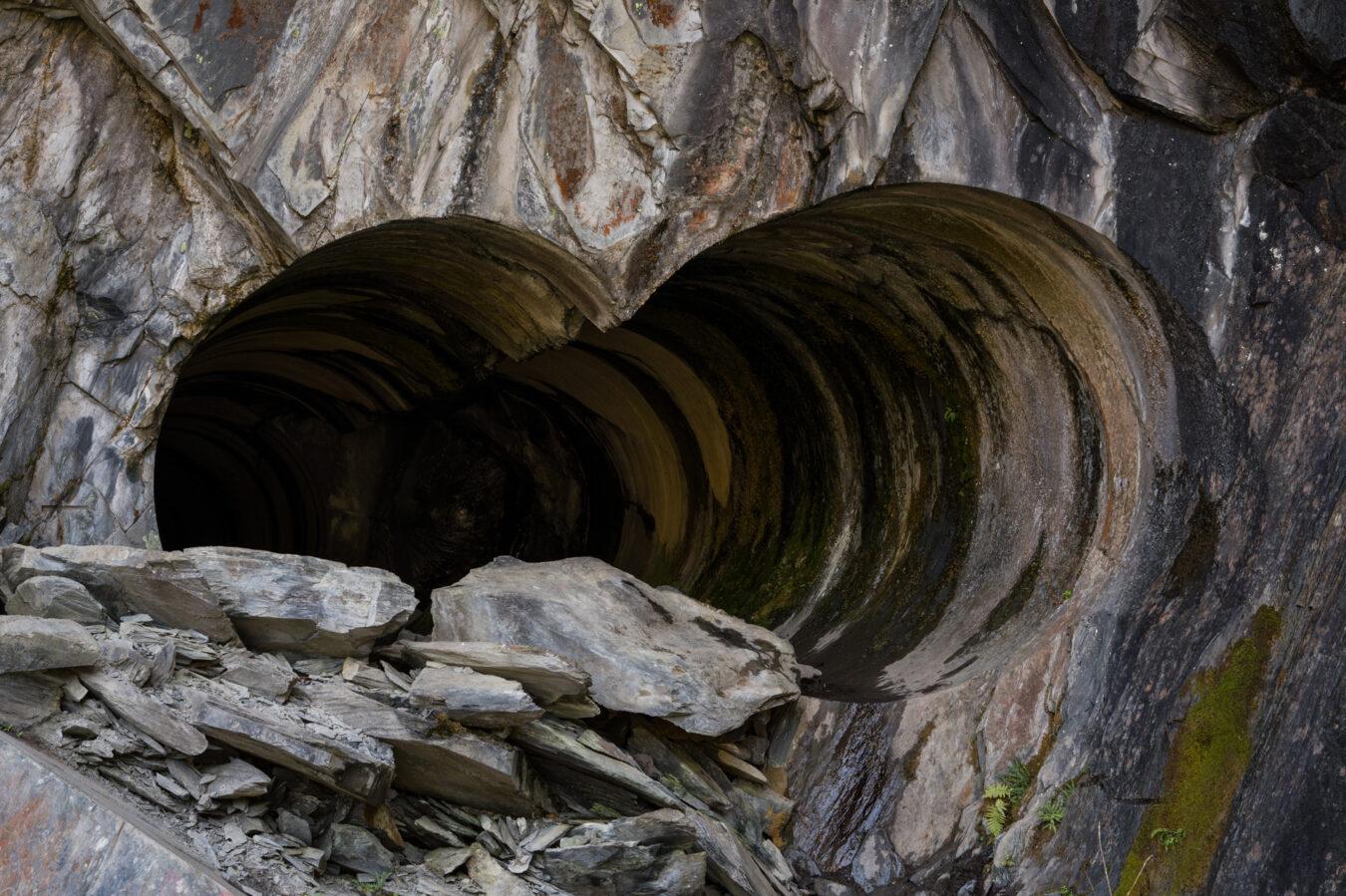
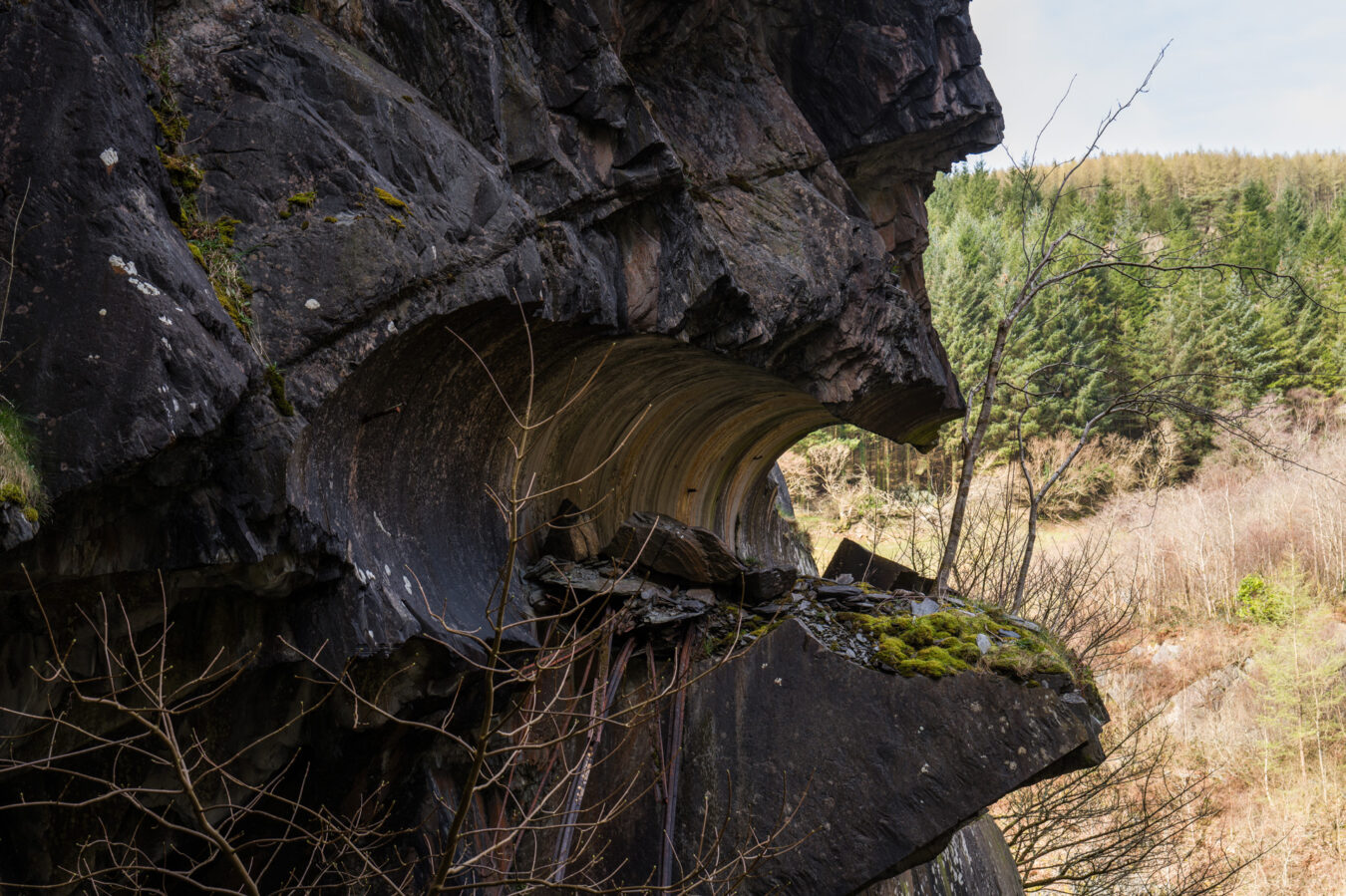
safety NOTICE
The more adventurous won’t resit climbing inside the tunnel, but please take extra care as there can be sharp objects left embedded in the rock that can lead to an instant injury to the head. Don’t venture deep inside any tunnel as various signs along the pathway warn about safety.
Walking Down and Back To Corris
Once you’ve finished exploring, it’s time to head back the way you came. When you reach the end of the dirt road — where the gate you passed through earlier is located — turn left and follow the country road down to Corris, passing some charming cottages along the way.
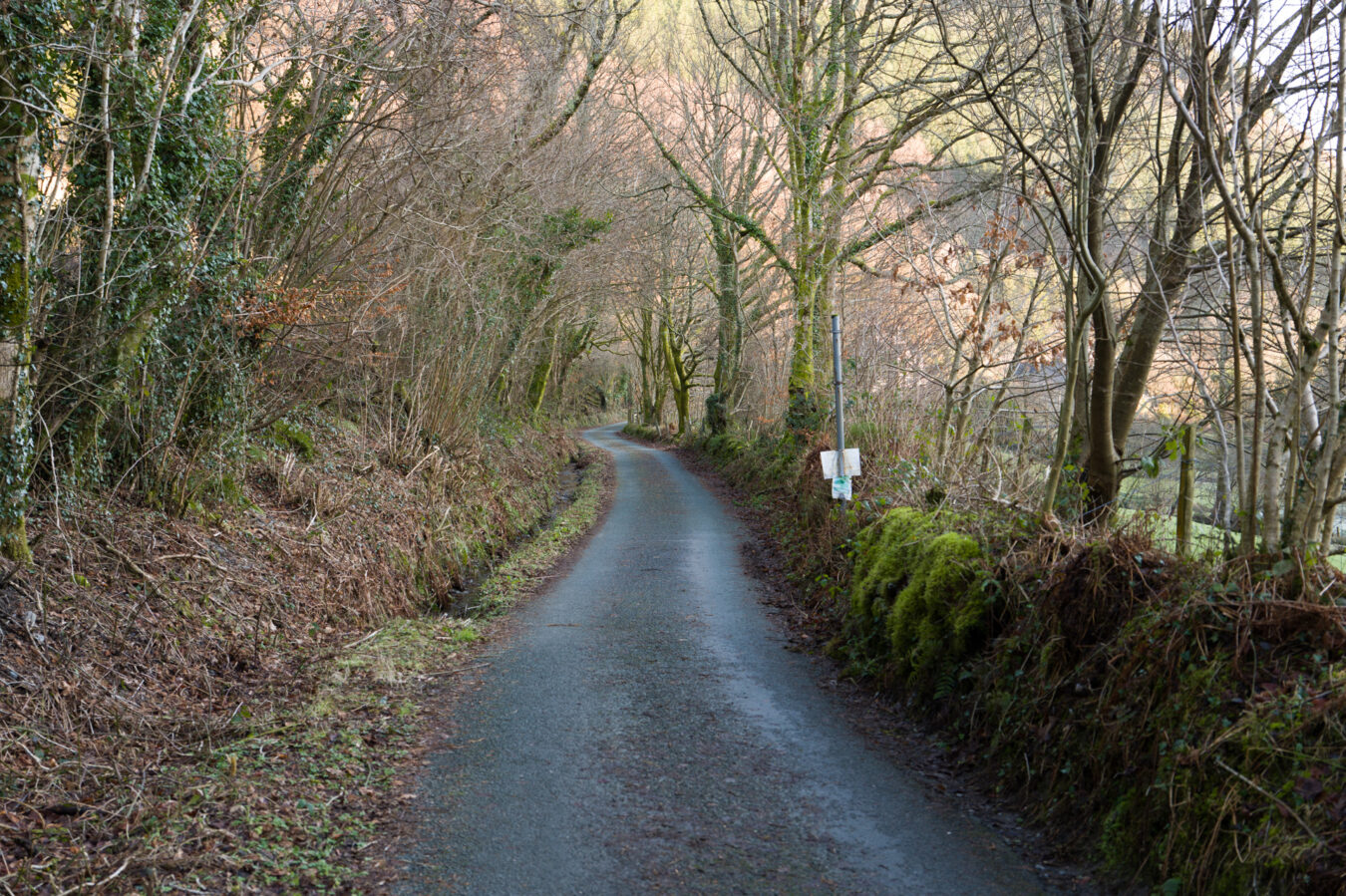
road closure
When I did the walk (January 2025), about 400 metres in (430 yd), I found the tarmac road closed and had to take a short detour via a path on the right side of the road. There is a bridge further along, but you don’t need to cross it—stay on the left side of the river. You’ll soon return to the road, where you’ll see why it has been closed: part of it has collapsed and is unsafe for vehicles.
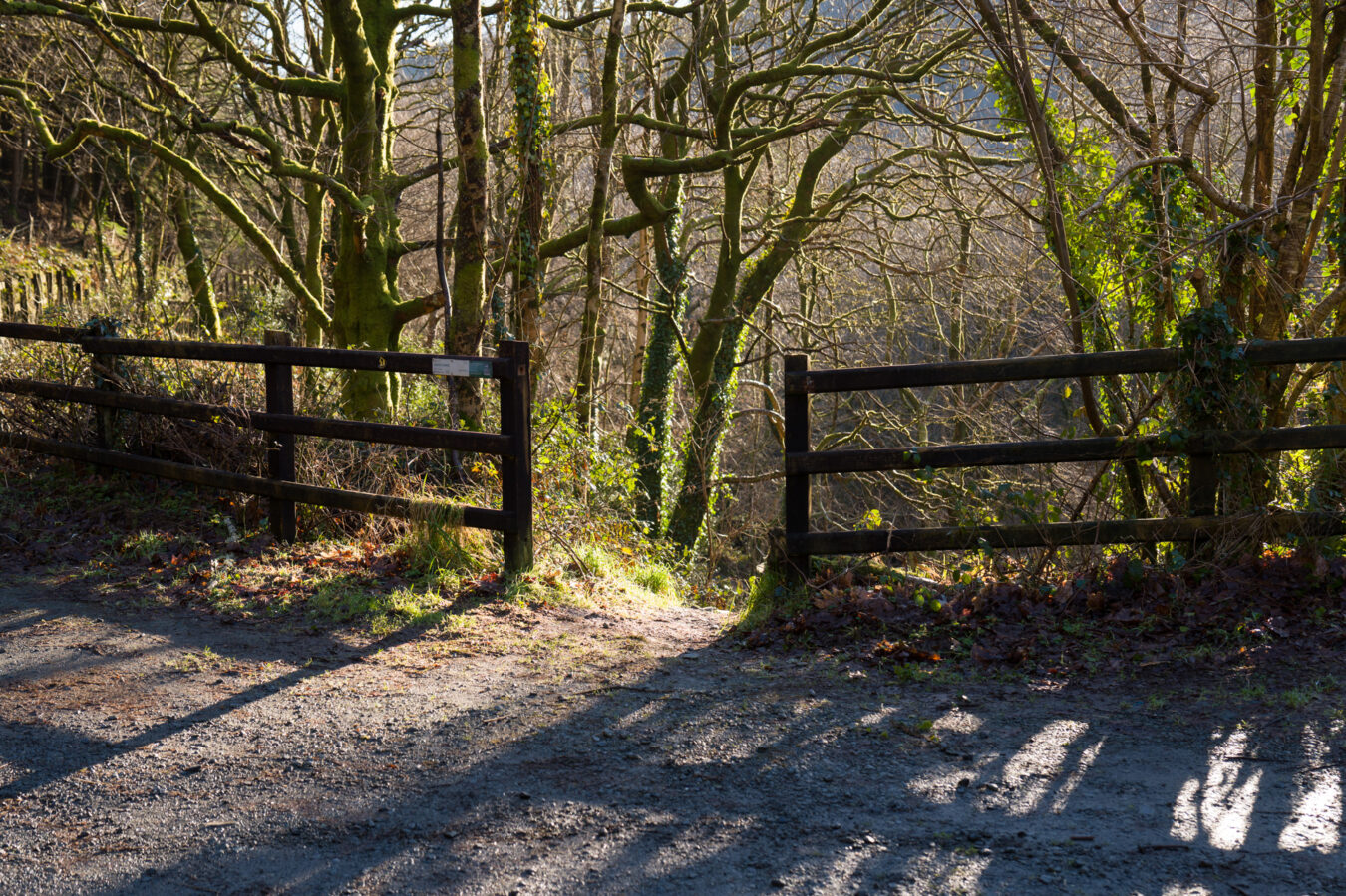

Keep walking down, and you’ll start to recognise the road you came from at the beginning. Eventually, you’ll reach the intersection again, with the Slaters’ Arms on your right this time. From there, you can stop for refreshments at the pub or head back to your car or bus stop the same way you came.
Other Things To Do In and Around Corris
Corris may be a small and hidden village, but there’s plenty to do in the area.
The Corris Railway operates from April to October on select days of the week. The steam train takes a short, gentle trip through the beautiful Dulas Valley, and your children will enjoy the ride, the playground, the free toys in the shop, and they may even have the chance to blow the whistle and wave the green flag during the journey. The train stops at Maespoeth, where you can visit the workshops, and additional toys are available for the little ones. The station in Corris also offers refreshments and a small, free-entry museum.
- Read more about narrow gauge steam railways in Wales
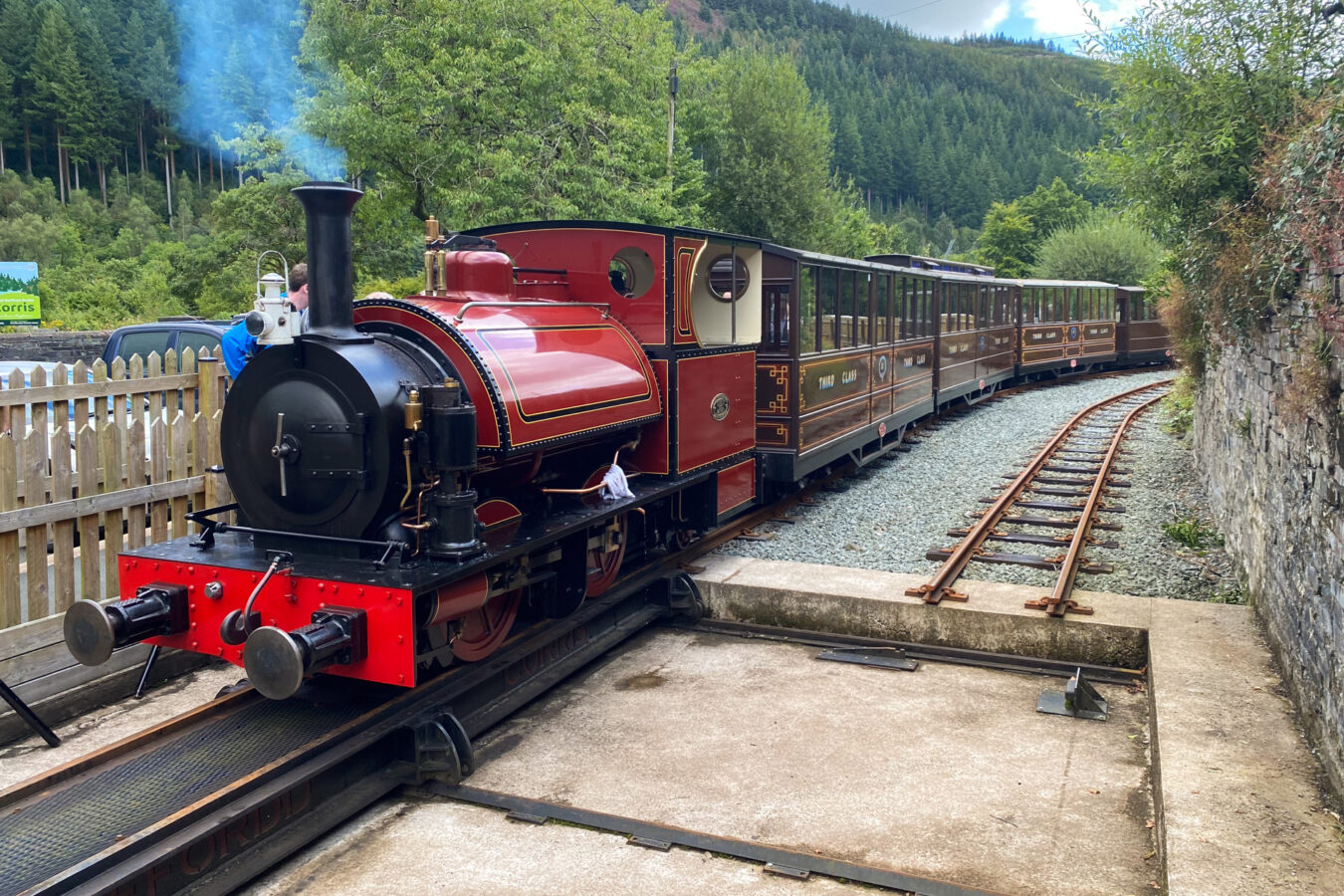
The Corris Craft Centre is another great family outing and can be easily combined with the walk. It has a lovely café offering both hot and cold meals, and you can explore the various shops and take part in craft activities, including pottery and chocolate-making!
Nestled on the same site is King Arthur’s Labyrinth, an underground adventure that takes you through Welsh legends and storytelling, with dragons, waterfalls, and much more!

